Tips for Arachnids
Extensively updated 18/10/2015
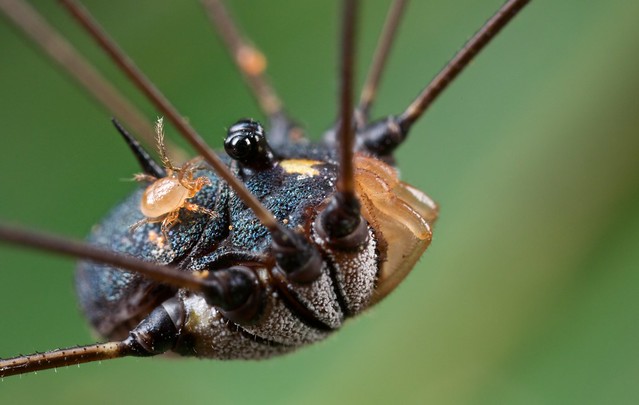
Harvestman with mite. Photographed in Cuc Phuong nationa park, Vietnam. Copyright Paul Bertner 2013.
With a background in biology, it should be noted that my interests have led me to to photograph naturalistic representations of in-situ subjects and behaviours. Therefore these tips do not include how to artfully balance a praying mantis on the head of a spider which is feeding on a fly. Rather this post is a distillation of natural history and photographic experience, possible challenges and maybe even occasionally a tip or something useful to someone, somewhere…
Arachnids are an incredibly diverse class, and as such the techniques governing their photography are also legion. For example, photographing orbweaver and other web-based spiders will differ from ambush hunters which in turn will differ from active hunters and mimics. These differences are obviously most pronounced between orders than between families and genera. Though one can be quite surprised at the morphological differences even between members of the same species let alone the same genus. All this to say that there are no hard and fast rules and that your shooting style will be largely dictated by in-situ environment, circumstance, subject form (not to mention equipment type and availability).
Arachnida (Class)
Orders
Acarina (Mites) , Amblypygi (Tail-less whip spiders), Aranea (Spiders), Opiliones (Harvestmen), Palpigradi (Microwhip spiders), Pseudoscorpionida, Ricinulei (Hooded tick spiders, Schizomida (Whip scorpions), Scorpiones, Solifugae (Sun spiders), Thelyphonida (Vinegaroons).
Many of these orders are quite uncommon and my own lack of experience in dealing with several of them cautions me against offering advice on their photography, so I will broadly divide them into groups based on my familiarity and shooting style rather than any kind of phylogenetic similarity: 1) Aranea 2) Amblypygi 3) Opiliones 4) Scorpiones 5) Thelyphonida and 6) Acarina and Pseudoscorpionida
Group 1 – Aranea
Introduction
When one speaks of arachnids, this is the order that one is generally referring to…the spiders. Although one could easily go down the phylogenetic tree until we’re parsing out species, I think of greater relevance are factors like substrate (Air (web builders), Ground (most others), and water (Fishing spiders, etc.), body type (pilose, smooth, iridescent), size, and natural history and behaviour. The former will dictate the considerations of tripod use, focus stacking, natural light/glare, and polarizing filters, the body type will dictate the amount of diffusion (1), while size will require the proper lens choice and decisions of <1:1, 1:1, or >1:1. Lastly an individual’s natural history will determine your approach Eg. Using a long lens so as not to disturb it, deciding whether to move on or wait for an inevitable behaviour or even to elicit a behaviour Eg. Defensive.
Remember that the vast majority of arachnids are harmless, and though they may appear quite fierce, even those that are capable rarely inflict bites unless unduly molested, preferring to save their venom for prey capture and/or true life or death situations. Having said that, many arachnids have defensive displays which can only be elicited by appearing threatening or manipulating them in a bothersome (though physically un-damaging) manner. I brooch this point more broadly in point 5 of the extensive tips, tricks and techniques section.
Tarantulas (Mygalomorphae), sydney funnel web spiders, Phoneutria and other venomous or painful biters will usually rear up to display their fangs and fan out their legs to appear larger. In the case of the former, they may also rub their hind legs against their thorax to release tiny irritating barbs into the eyes of potential predators.
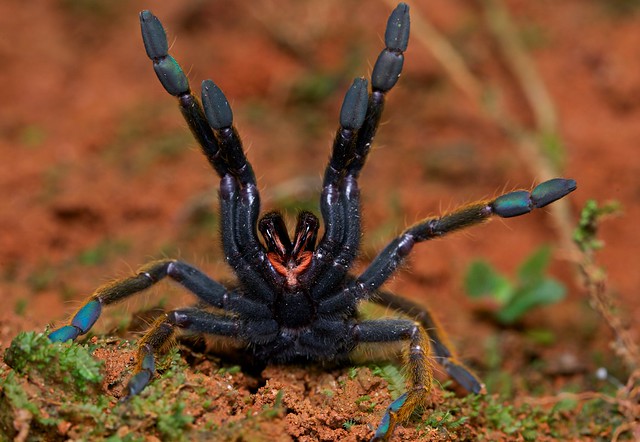
Black and olive baboon tarantula (Encyocratella olivacea) in threat posture. Photo from Amani nature reserve, Tanzania. Copyright Paul Bertner 2014.
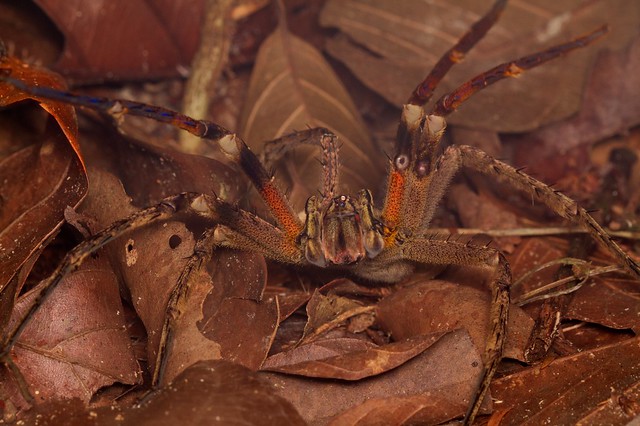
Brazilian wandering spider (Phoneutria sp.) in typical legs up threat display. It should be noted that although I have never had any problems photographing this genus, they do have a reputation for being fast, aggressive and jumping. Venomous species should always be handled with caution. An old photo that barring the technical imperfections is still interesting from a behavioural standpoint. Photo from the Kanuku mountains, Guyana. Copyright Paul Bertner 2010.
In photographing spiders, like most insects, the focal point should be on the head and eyes, though this can be complicated by the mouthparts and fangs (more difficult for the smaller species where higher mag and smaller dof is required) which one would ideally like to get in focus as well. However, the head is usually static (minus the possibility of cheliceral movement in feeding subjects) therefore restricting the creative range with respect to poses. These portraits are predominantly of salticids, where the huge anterior median eyes (AMEs) make for a point of interest and anchor for the rest of the photo. These photos can be unquestionably beautiful, especially with properly diffused lighting, proper background and adequate depth of field. It should be noted that many photographers keen on this method have galleries and galleries of salticids all shot more or less the same way. In this respect, the lack of image creativity and diversity has led to a certain staleness whose only safeguard is not the skill of the photographer themselves but rather the inherent beauty of their subject.
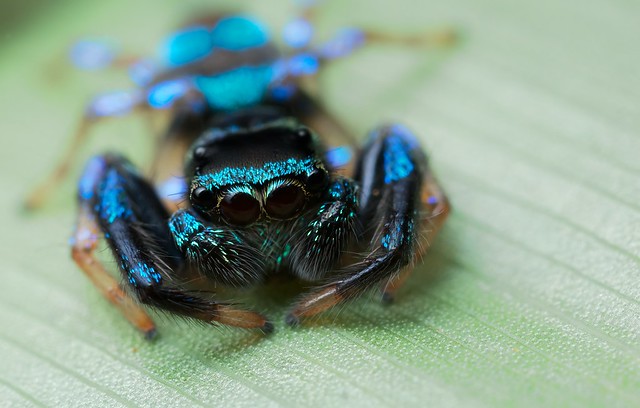
A technically well-conceived and executed photo with a beautiful fighting spider (Thiania bhamoensis). I like this photo, I won’t lie, but I don’t see it as anything more than a beautiful jumper well-portrayed, unlike some of the images below. Photographed in Preah Monivong national park, Cambodia. Copyright Paul Bertner 2013.
These kinds of images fail my “google lineup test”. A quick test in which I type in an images’ keywords and species name and look for sufficient differences between my photo and the search results.

This is an early photo of a jumping spider with membracid prey which fails my google lineup test. Technical considerations aside, the perspective isn’t particularly bold or interesting. There is little of aesthetic value and it is primarily a record shot of predation. Photographed in Mahdia, Guyana. Copyright Paul Bertner 2010.
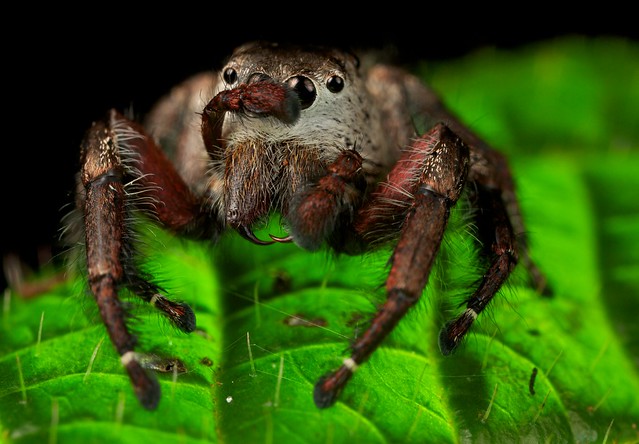
A more distinctive photo thanks to the palp covering the eye, the visibility of the chelicerae and the electric glow of the backlit leaf. These elements help elevate the photo and give it a distinctive look which I readily recognize as my own. Photographed in Amani nature reserve, Tanzania. Copyright Paul Bertner 2014.
I think the main way to avoid the stale photo syndrome is to actually back off on magnification, provide more background and more foreground elements, and include behaviour wherever possible. Let the morphological features be your guide to what kind of shot you take and change your style often. I provide detailed reasoning and photo pairs on the subject under point #20 “It’s all a matter of perspective“. If you’re still keen on these kinds of shots and you find that the jumpers won’t readily oblige in their poses and seemingly look everywhere but where you want them to, then bare in my mind that they tend to naturally jump higher rather than lower. So you can get them to look up by putting your finger or a stick slightly above them with one hand while you shoot with the other as they prepare to jump.

“The Viewpoint” – Easing off on the magnification and allowing for a clean, uncomplicated background, in addition to the green out of focus leaf blade gives a kind of zen feeling to the photo. The negative space highlights the subject which is clean and in focus. Photographed at the ACCB park, Cambodia. Copyright Paul Bertner 2013.

Male (top) and female (lower) ant-mimicking jumping spiders (Myrmarachne sp.). Getting both male and female in the same shot, in the same focal plane and with the proper lighting on both was an exercise in patience in frustration, but it is certainly different from the other photos in the Google lineup. Photographed in Danum Valley Conservation Area, Borneo. Paul Bertner 2014.
Everyone is so focused on the head and the eyes that there is room for a lot of creative endeavours out there, abstracts, 5-10X magnification detail work, and novel perspectives.
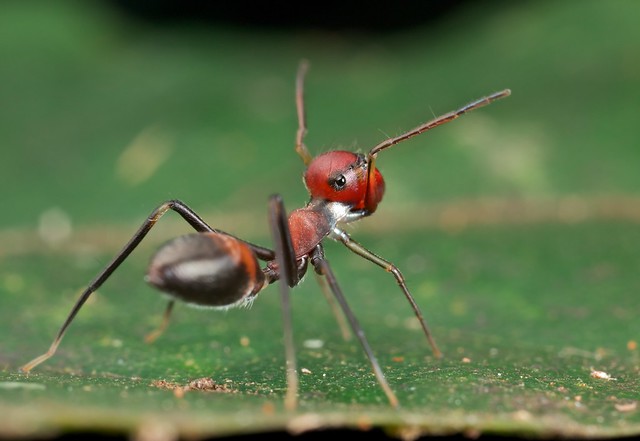
A different female but of a similar ant-mimicry complex (Myrmarachne sp.). The raised forelegs and small eye depicted here emphasizes the spider’s behavioural mimicry of its host ant in a way that a simple facial portrait does not. In fact, many jumping spiders will continuously turn around to view the photographer, therefore it is in actuality probably more difficult to get a shot of one with its back turned. Photographed in Danum Valley Conservation Area, Borneo. Paul Bertner 2014.
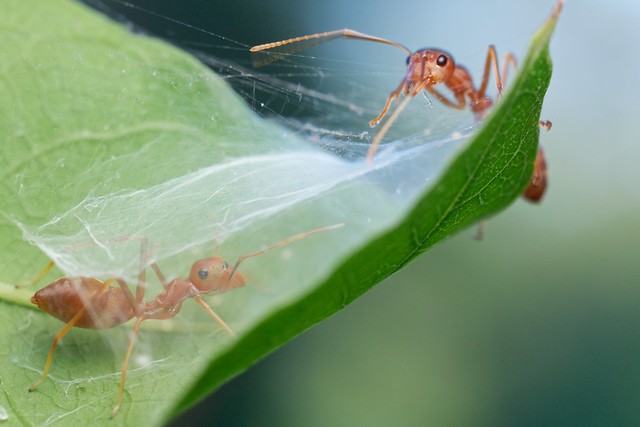
Possibly one of my favourite jumping spider shots, this one depicts the weaver ant (model) and jumping spider (Myrmarachne plataleoides) mimic facing off. The jumping spider retreat was built on the underside of a leaf, on a tree occupied by a colony of weaver ants. Seeing an approaching weaver ant, I knew it was only a matter of time before it would check out the silken burrow. It climbed beneath it, around it and finally after a few minutes directly over top. The spider alerted to the presence raised its legs and then perhaps realizing its peril quickly backed away and dropped from the leaf on a dragline, climbing back up when the danger had passed. Photographed in Angkor Wat, Cambodia. Copyright Paul Bertner 2013.
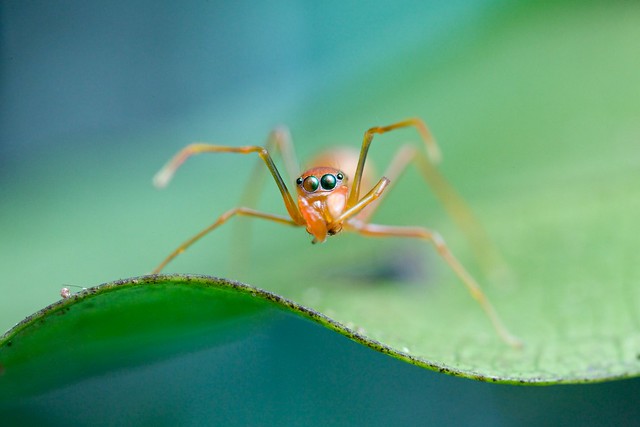
An example of backing off on the magnification in order to include elements of the “macroscape”. The wave-like leaf margin provides an organic and smooth trajectory for the eye to follow. There is still good detail in the eyes and head, and indeed they are still the focus of the image, but they are not everything. Weaver ant-mimicking jumping spider (Myrmarachne plataleoides). Photographed in Angkor Wat, Cambodia. Copyright Paul Bertner 2013.
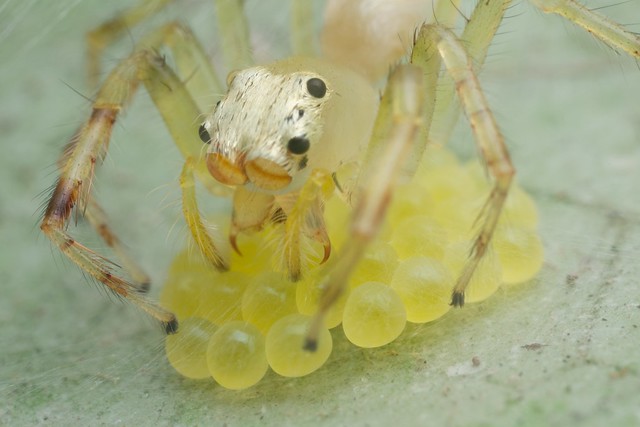
A female jumping spider protecting and cleaning a clutch of eggs. She gently picks them up in her chelicera and maneuvers them around, preventing the settling of fungal spores and other contaminants whilst coating them in anti-bacterial/anti-fungal saliva. Photographed in Bukit Barisan national park, Indonesia. Copyright Paul Bertner 2013.
Obviously there is a place for portraits, my main criticism is that they should not be the full repertoire or even the ‘go-to’ shot. Mix up natural light portraits with flash and solid white/black backgrounds. The below portraits are indeed some of my favourites, however, it is the second photo in each pair that I would actually be more loth to part with.
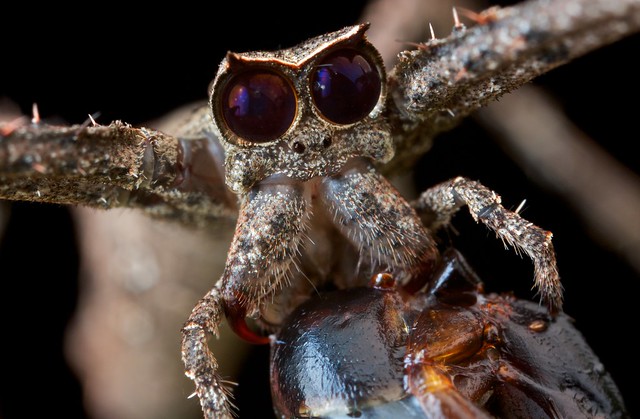
Ogre faced spider (Deinopis sp.) with prey. Photo from Udzungwa national park, Tanzania. Copyright Paul Bertner 2015.
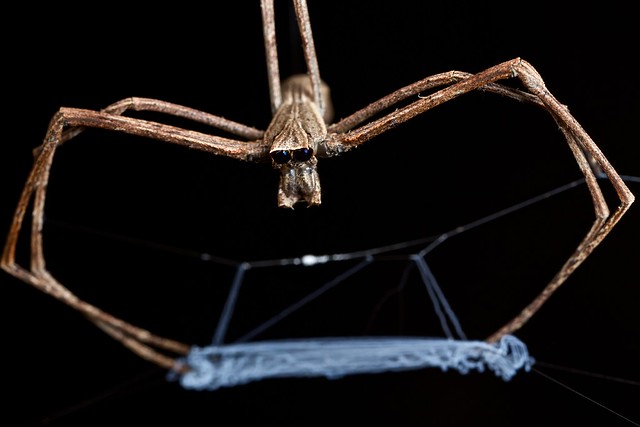
Ogre faced spider (Deinopis sp.) with net. Photographed in Udzungwa national park, Tanzania. Copyright Paul Bertner 2014.

Weaver ant-mimicking crab spider (Amyciaea sp.). Photo from Udzungwa national park, Tanzania. Copyright Paul Bertner 2015.
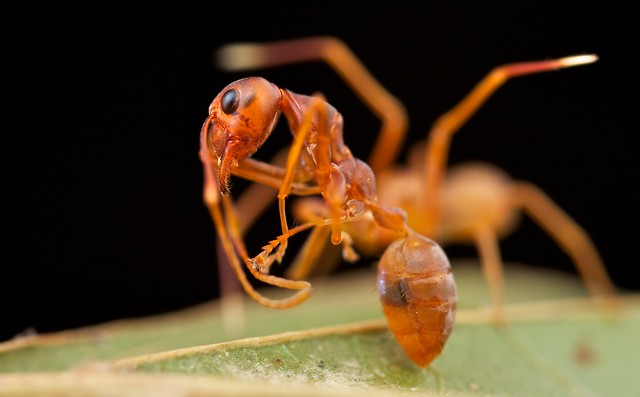
A subtle photo where the predator is in the out of focus background. To someone not familiar with the ecology or natural history of the species, they might not be able to entirely understand the image without a caption. However, to those who do know, it presents an uncustomary look at the predatory behaviour of the weaver ant-mimicking crab spider (Amyciaea sp.). Photographed in Udzungwa national park, Tanzania. Copyright Paul Bertner 2013.

Male large-jawed spider (Tetragnathidae) portrait. Photo from Udzungwa national park, Tanzania. Copyright Paul Bertner 2015.
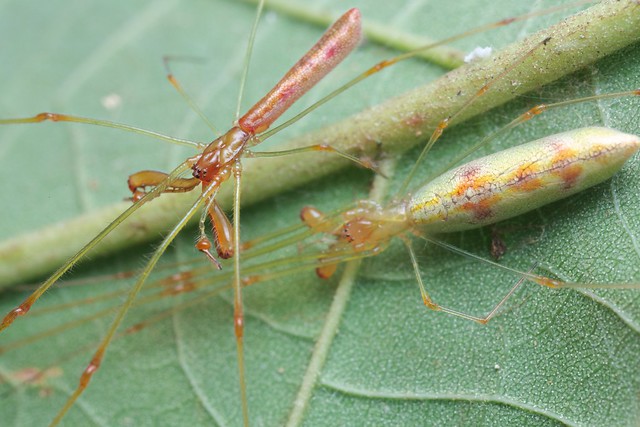
Okay, so I actually do prefer the first image in this pair. It is more visually striking and there aren’t too many tetragnathid portraits out there for me to feel like mine is just one within a multitude. Having said that, this shot nicely illustrates the sexual dimorphism of these large-jawed spiders (Tetragnathidae). Photographed in Angkor Wat, Cambodia. Copyright Paul Bertner 2013.
It bears mentioning that certain species display armature and other morphological points of interest that can and should be taken into account, lending more interest than a simple AMEs portrait. For example Gasteracantha and Micrathena sp. typically have interesting spots, and dorsal ornamentation which lend themselves well to a dorsal or anterior-dorsal shot. If one wishes to photograph the insect in its entirety, their relatively static nature, length, and three-dimensional nature of the spines (demonstrated to the extreme by Gasteracantha arcuata and Micrathena cyanospina) make them amenable to either focus stacking or else wide angle macro. Otherwise, a closeup of the spines or dorsal patterning can make for an interesting abstract.
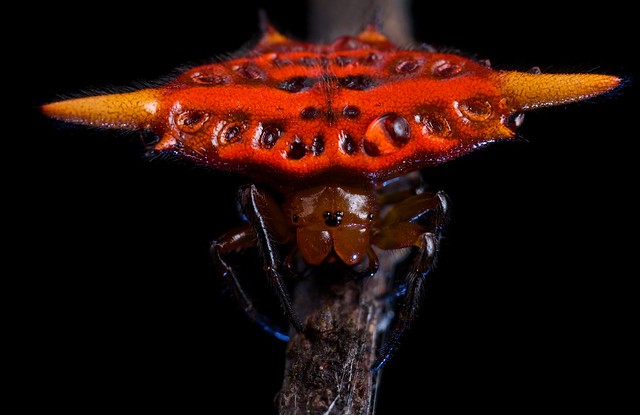
A dorsal-anterior view of a crab orbweaver (Gasteracantha versicolor) reveals the eyes and lovely colours and patterning and spines. Photo from Ankarafantsika national park, Madagascar. Copyright Paul Bertner 2015.

Biscuit kite spider (Isoxya tabulata). Photo from Udzungwa national park, Tanzania. Copyright Paul Bertner 2015.
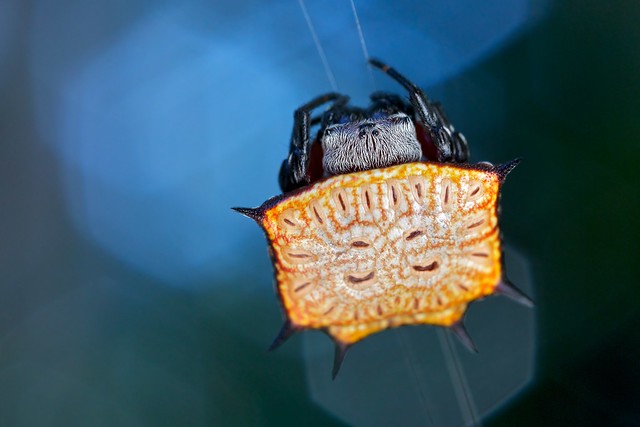
Biscuit kite spider (Isoxya tabulata). Photo from Udzungwa national park, Tanzania. Copyright Paul Bertner 2015.
Part II – The sky-dwellers (Araneidae)

Devil’s crab orbweaver (Gasteracantha falcicornis). Photograph from Udzungwa national park, Tanzania. Copyright Paul Bertner 2014.
The main problem with photographing orbweavers in their webs with natural light is that wind will almost certainly cause a degree of motion blur. Therefore it is advisable to a) Look for orbweavers in sheltered areas, or within forested areas 2) Look for either juveniles or subjects with smaller webs which are less prone to the large amplitude vibrations of larger webs 3) Create a wind buffer, an umbrella attached to a tripod or tied around a tree can work for modest wind speeds 4) Failing #3, note the position and return when there is less chance for wind 5) Use higher ISOs and faster shutter speeds 6) Use a short fill flash burst 1/64-1/16 depending on the amount of available light 7) Failing all else you can move the spider to a sheltered branch, many will immediately drop a dragline and dangle. However if you wait or return later, they will often build a few secure ‘hammock’ lines on which they rest before building a new web. These lines generally provide enough distance from the physical substrate to get clean natural light shots, but are close enough to the substrate that there is less chance of the wind interfering.
The use of a tripod will obviously help with blur caused by camera shake, however I have often found that the smallest puff of wind was enough to cause blur and in addition to the comparatively lengthy setup and lack of flexibility, subjects were often too high or else inconveniently located. The exception to this is cloud forests, where the cool air and humidity forms an abundance of rain drops, especially in the early morning, making deep focus stacks with natural light a possibility.
The below shot was taken without the use of a tripod at f/10, 1/125 and ISO 1000. The relatively fast blur-stopping shutter speed and small aperture was only possible due to the position of the subject. By shooting upwards on a clear sunny day I was able to maximize the amount of light hitting the sensor, whilst the canopy prevented glare. Had I shot horizontally instead, I would have had to sacrifice dof or shutter speed.
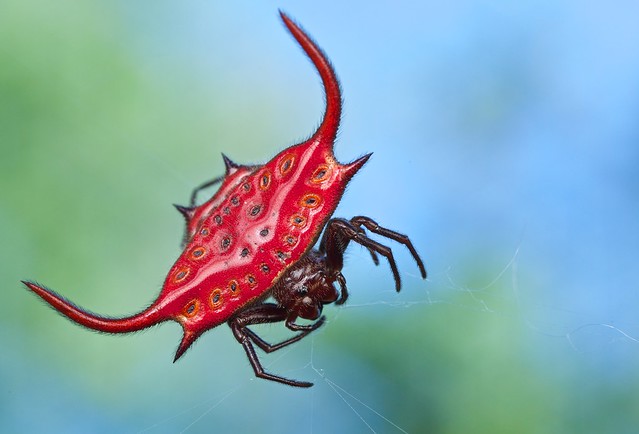
This shot of a devil’s crab spider (Gasteracantha falcicornis) illustrates the above points; the complementation of a dorsal perspective with natural light. Photo from Udzungwa national park, Tanzania. Copyright Paul Bertner 2015.
Leaves, and branches don’t necessarily have to be elements that have to be meticulously angled, cropped or photoshopped out of the photo. Rather seek to incorporate them in a way that can complement the subject.

This net-casting spider (Menneus sp.) is indeed more interesting while holding its net aloft (See photos below) than when hugging a branch. However, it is now its wonderful camouflage which is on full display. Photo from Udzungwa national park, Tanzania. Copyright Paul Bertner 2015.

Natural light, backlit leaves and the similarly angled perspective of the spider (Argiope sp.) and leaves all contribute to the impact of the photo. Photo from Udzungwa national park, Tanzania. Copyright Paul Bertner 2015.
Other times, the web and hanging posture are detractions. I find that when photographing bark spiders (Caerostris spp.) that their heavy, clunky bodies look rather ill-fitted to a web and that they appear much more at ease when camouflaged on a branch or tree trunk. Not to mention that their web building activities are nocturnal. One exceptional circumstance is the photo below involving a somewhat complicated setup which has sound theory though a questionable execution.
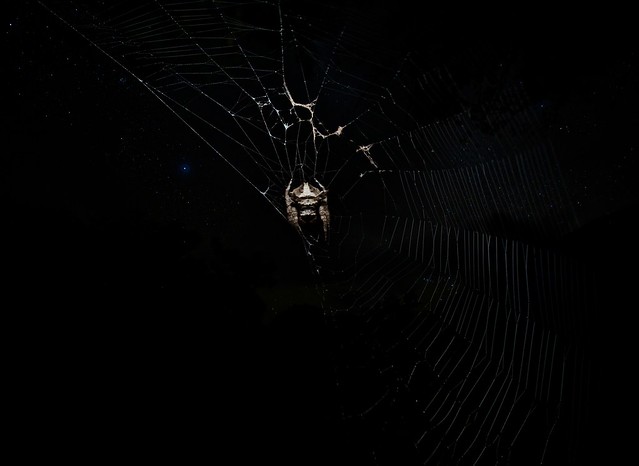
“Catching the stars” – Bark spider (Caerostris sp.) on web at night. Although I didn’t quite realize my intention due to lack of stars, it is an idea that I have been playing with. The main obstacles are a clear night sky, a motionless subject and zero wind. I used a technique that can only be accomplished in the dark and only with a manual lens. I set the shutter speed to 30″ and then tripped it by remote. I was already focused to infinity, and then I manually rotated the lens barrel to a predetermined spot (which I noted before the shot) to close-focus on the spider. I then stopped down (all while the camera was still taking the picture), this allows an in camera manual focus stack of the spider and stars, as well as providing enough light for the stars to appear. Because there is essentially no light, there is no motion blur caused by moving the camera, changing settings, and rotating the lens barrel. Finally a brief 1/128 2nd curtain flash is fired at the end of the shot from the side in order to illuminate and give texture to the web and spider. Photo from Maromizaha special reserve, Madagascar. Copyright Paul Bertner 2015.
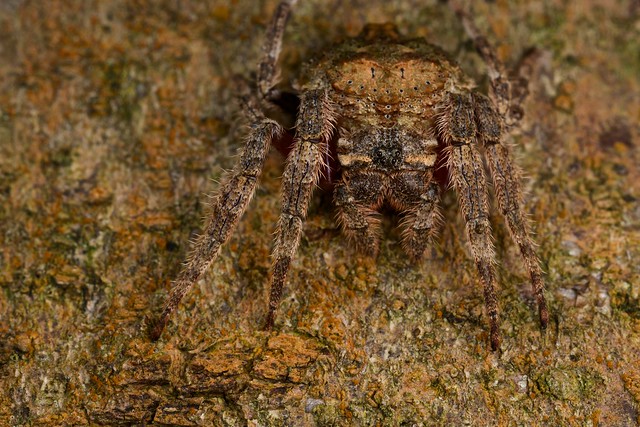
This rather conventional anterior perspective of this bark spider (Caerostris sp.) is redeemed by the rich colour palette and textures of the bark and spider hairs. Photo from Maromizaha special reserve, Madagascar. Copyright Paul Bertner 2015.
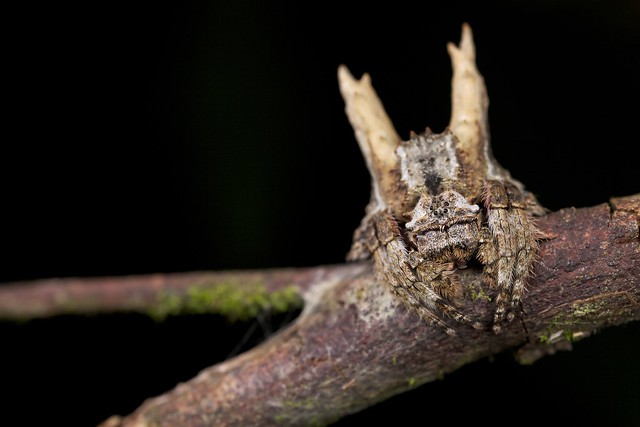
Although technically satisfactory, this early Bark spider (Caerostris sp.) photo lacks the dynamism, perspective and uniqueness of other shots I’ve taken of this species. It is the spider’s own morphology which lends distinction to the image. Photo from Andasibe national park, Madagascar. Copyright Paul Bertner 2012.
Photographed head on, these spiders are readily discernible from their eyes. However, when photographed from a different perspective, dorsally or posteriorly, then the unfamiliar shapes aren’t as readily made sense of and the camouflage can become something to truly marvel at.
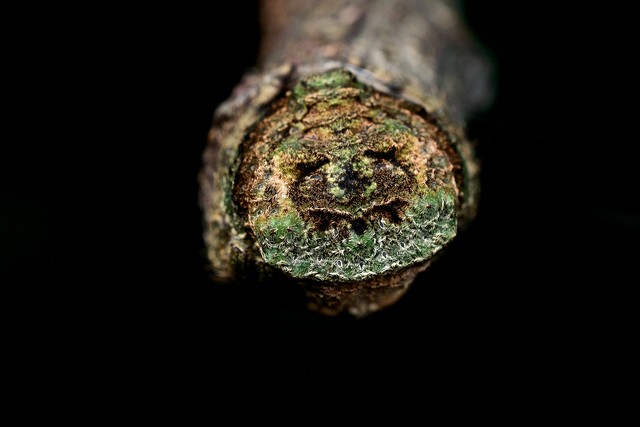
Bark spider (Caerostris sp.) curled up at the end of a branch, shot dorsally to emphasize the appearance of the broken branch masquerade. Photo from Amani nature reserve, Tanzania. Copyright Paul Bertner 2015.
The dark browns, greens and blacks of most bark spiders make nighttime shots a particularly suitable alternative. However, for the unique bark spider below, composed of yellows, greens and reds, I thought that a daytime, natural light background would be more suitable and complementary. This is the first such spider that I have seen that appears to mimic either a plant node (“the part of a plant stem from which one or more leaves emerge, often forming a slight swelling or knob”) or bud (“an undeveloped or embryonic shoot that normally occurs in the axil of a leaf or at the tip of the stem”).
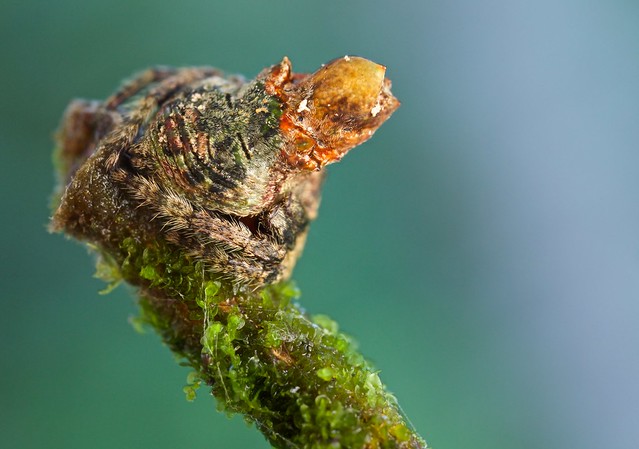
Bark spider (Caerostris sp.) camouflaged as an emerging bud or node. Photo from Torotorofotsy, Madagascar. Copyright Paul Bertner 2015.
On occasion, it is actually the webs themselves which take centre stage. For example, Cyclosa spp. are relatively diminutive and unassuming. However, subterfuge is the name of the game within this genus. Recognized by their elongated abdomens, these spiders after completing a basic orbital web, they incorporate detritus and insect remains into their webs along either discoid or axial stabilimenta (a white, opaque silk). The purpose of this brand of silk remains contested, though studies have shown that prey capture rates may increase by as much as 50%. This intriguing phenomena is likely due to the silk’s reflectance properties, which extends across the entire insect spectral range including UV, an adaptation to UV-vision biased insects. Stabilimenta also increases the size of the spider sometimes by as much as 10x and since nature is governed by the general principle that size and strength are correlated, this form of mimicry may decrease their desirability to predators such as wasps. Other theories include alerting avifauna and other large bodied animals to the presence of the web or else, as the name would suggest, to stabilize the web, since stabilimentum silk has a greater strength and crystalline structure than either capture or dragline silk used in the rest of the web. Stabilimentum often has detritus and insect remains woven into it helping to serve as camouflage and perhaps even as a chemoattractant in the form of pheromones, in addition to the aforementioned properties. Interestingly this controversial topic neglects to take into account the various patterns employed by different araneids in their use of stabilimentum silk.
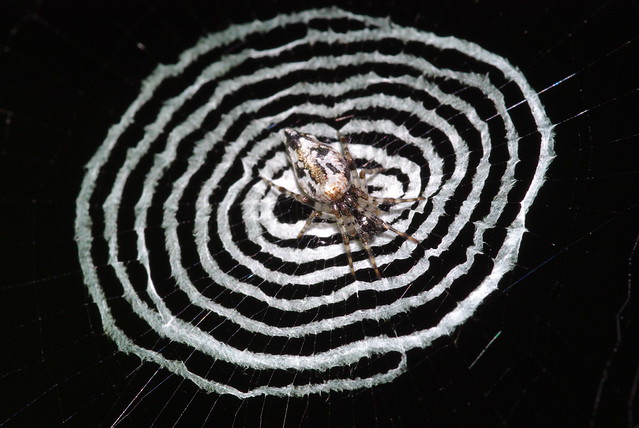
A web debris spider (Cyclosa insulana) builds some of the most extraordinary webs and so they really need to be showcased in their microcosm. The circular white thread, a thread quite distinct from that used to form the rest of the web is the stabilimentum. Spiders can form up to 7 different kinds of silk from their spinnerets, modifying the basic silk polymer by different extrusion mechanisms. The purpose of the stabilimentum isn’t fully known. It’s thought that it might be used to alert birds from flying into and destroying the webs. Photographed in Maliau basin, Borneo. Copyright Paul Bertner 2010.

Web debris spider (Cyclosa sp.) camouflaged amongst imported debris. Photographed in Hitoy-Cerrere reserve, Costa Rica. Copyright Paul Bertner 2013.
Most webs you will find are oriented vertically and can often be out of reach, which can make shooting a different perspective challenging. There are several options: 1) Find a new vantage point (yes, easier said than done!) 2) Gently tap the web. This will often send the spider scurrying from the centre of the orb to a branch or connection point to the web, but not without first clambering across the horizontal tightrope which constitutes the frame. This short stretch provides an opportunity to get a good perspective.
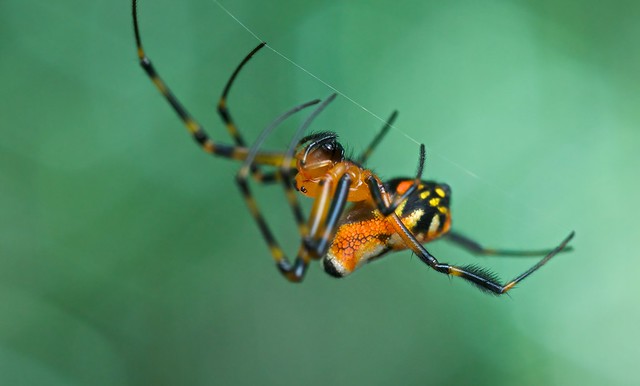
Leucauge spider (Opadometa fastigata) climbing across frame line out of the web in response to a gentle tapping. Photographed in Angkor Wat, Cambodia. Copyright Paul Bertner 2013.
3) Gently blowing on the web may cause the spider to curl up and hunker down. However it may also cause it to change position, from up to down or vice versa or else from one side of the web to the other.
Some spiders, like the theridiidae make tangle webs which are three-dimensional. Alternatively, the sheet web spiders make horizontal webs. Both present great opportunities to get around the subject and shoot a different perspective. The nursery web spider (Pisauridae) below has a confusing web that loosely looks like a ball, but when an insect enters through the loosely spaced exterior web strands and runs into the internal lines, there is panic and in their fright, their emergency reflexive behaviour causes a hasty and ill-fated retreat which leads to further entanglement. By getting below and slightly off centre and shooting with a longer lens, I was able to keep out of the web and not disturb the catch. With no ambient light, I didn’t have to worry about background or bokeh and grain to a lesser extent, so I pushed the aperture to f/14 and the ISO 1000.
When shooting at night, unless there is some amount of light coming from the side or behind the subject, then often web detail can be lost. Consider orienting a flash behind and to the side of the subject, or else increasing shadow detail and/or dodging web lines for accentuation in post-production. During the day this is less of an issue and the web typically takes backseat to the spider and the background.
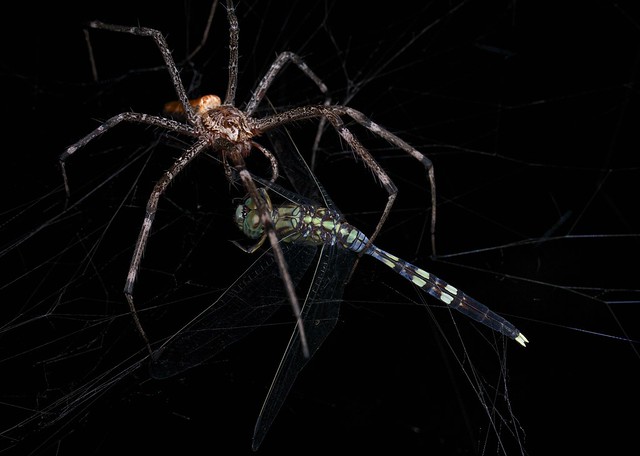
Spider with dragonfly prey. Photo from Udzungwa national park, Tanzania. Copyright Paul Bertner 2015.
It pays to be attentive as to what else might be in the web besides its maker. Oftentimes a web can play host to a variety of kleptoparasitic spiders and flies, a veritable community, which takes shares of any prey caught within.
Net-casting spiders, Ogre-faced spiders, Deinopidae, whatever you choose to call them, their unique strategy and posture make them particularly photogenic. The challenge is often that they are either located too close to the ground, or else they are found amidst a crowd of foliage which is impossible to navigate without causing them to drop their nets. Unfortunately there’s not much to say about this. Either find another specimen, or else note the location and return the following night after having pruned away some of the obtrusive vegetation. Look at upper to mid-level vegetation rather than that found below the waist which will be more difficult to shoot up into to photograph the large eyes. If you do cause one to either drop its web or else maim it, then give it an hour or so and it should have rebuilt it.
In a curious quirk of evolution, the Deinopidae or net casting spiders which branched early on from the araneids combine web building with a more active hunting strategy. They build a small rectangular web, stretch it between their front two pairs of legs and dangling motionlessly above their prey, ambush them. Unlike in araneids, the capture silk is replaced with cribellate silk (which gives it a wooly appearance), however it remains just as efficient at trapping prey. Deinopid webs remain similar to the aforementioned orbweaver template with several variations important for prey capture. Dangling as it does, how does a deinopid drop fast enough to ensnare its prey? The answer lies in two modifications to web design. First, a vertical safety thread tethers the web and gives it a slight conical shape while construction is in progress. When the web is completed, the spider holds this high tension safety thread with its second pair of hind legs. When prey passes by, it releases the safety line catapulting the spider forward at great speed. Another difference is the use of a bridge line, built slightly above the capture web. This line is held with with the first pair of hind legs and allows the spider a surface to pull down on to generate a downward force.

Net-casting spider (Menneus sp.). Photo from Udzungwa national park, Tanzania. Copyright Paul Bertner 2014.
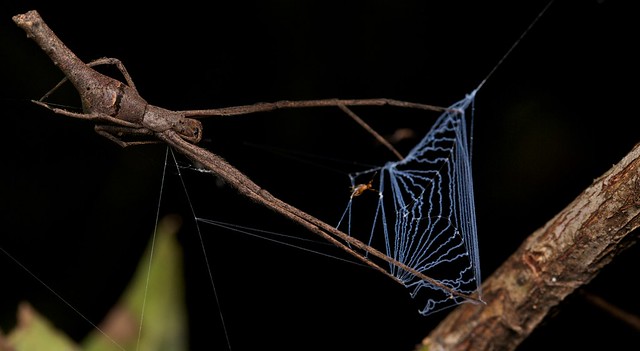
Net-casting spider (Menneus sp.). Photo from Udzungwa national park, Tanzania. Copyright Paul Bertner 2014.
Hanging pendulously from her perch, she remains still, her camouflaged form allowing her to blend in seamlessly with the branches overhead. She waits until nightfall when her huge anterior median eyes provide an unrivalled night vision, their lenses with an f/0.58 (f=aperture size, smaller number being large diameter) mean they are able to concentrate light more efficiently than a cat (f/0.9) or an owl (f/1.1). She owes this sensitivity to the light activated molecule rhodopsin, tightly packed into a microvillar membrane (which dramatically increases the surface area). Amazingly, 1500 times as many photons reach the light receptors in her eyes than the rods in our own eyes. She even accomplished this without the presence of a tapetum, a reflective membrane used to concentrate available light in many other nocturnal animals. Her preparation is impressive, she has staked out an ambush location, first having inspected it for loose debris and anything that might entangle her web, next she builds her web tentatively prodding the ground with her foot, ensuring it is set at the proper height. She may have even gone so far as to drop several faecal spots to guide her aim. In this manner she hangs, and patiently waits … An insect passes below, oblivious to the danger above. In a fraction of a second, the safety line has been cut, the web has been stretched 4 times its former size and before the insect even recognizes the danger, it finds itself helplessly trapped, venom coursing through its body. She feeds.
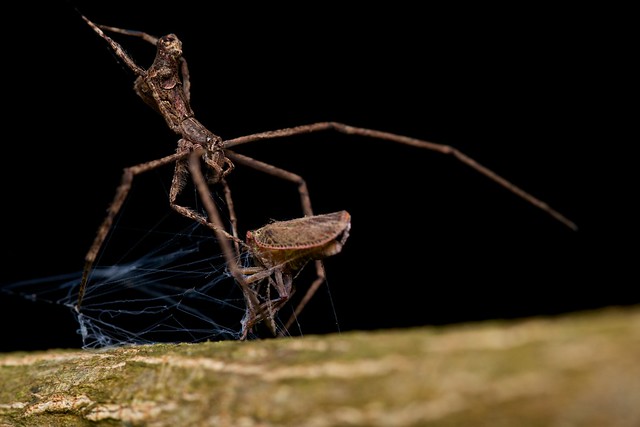
Net-casting spider (Menneus sp.) with prey. Photo from Udzungwa national park, Tanzania. Copyright Paul Bertner 2014.
However her work is not done. The rhodopsin which enables her unparalleled night vision is so sensitive to light that daytime exposure would actually destroy it. Thus, at dawn, the spider spends the first 2 hours dismantling the light sensitive microvillar membrane and rhodopsin molecules. The latter subsequently migrate behind a protective pigment layer, effectively rendering them less sensitive to light. When dusk falls, the light sensitive membrane is once again renewed, web building is resumed and the hunt can begin anew.
(Deinopid hunting strategy excerpted from an earlier article on Araneid web building strategies)
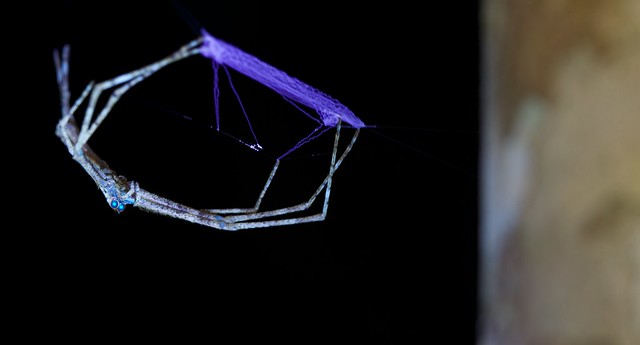
The huge AMEs show high UV reflectance, creating an eery, nightmarish feel to the image. Photographed in Andasibe national park, Madagascar. Copyright Paul Bertner 2015.
The Araneidae that we have so far examined have been mostly stationary web builders. Before we move onto the ground and understory dwellers, let us consider the peculiar tribe of bolas spiders and the females’ unique method of capturing prey, which illustrates nicely the importance of patience and the decision of whether or not to wait, or revisit a subject to view behaviour.
During the day they are at rest and fairly unresponsive. Undoubtedly they possess an interesting physiognomy, often camouflaged as bird droppings or other unpalatable fare and thus suitable for portraiture; however, the real point of interest is their hunting strategy which can only be seen at night.
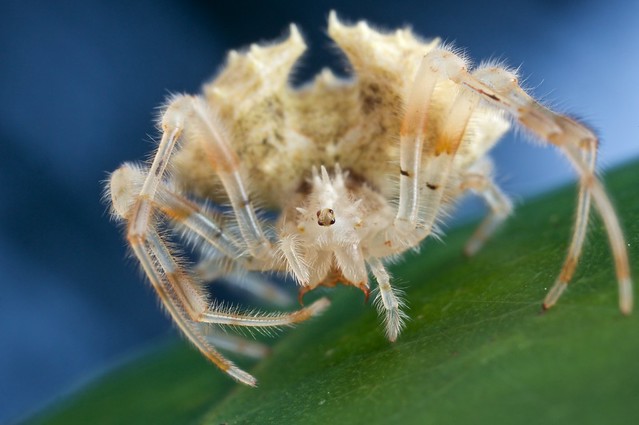
Bolas spider (Exechocentrus n.sp.) from Andasibe national park, Madagascar. Copyright Paul Bertner 2015.
And so, as darkness descends, the bolas spider emerges from its daytime slumber, finds a suitable location free from obstructions and begins to build. It is not a web in any recognizable sense, but rather a single long silken line to which it attaches globule(s) of a glyco-protein glue; together, they form the bolas. The silken line is made of a relatively rigid silk, not like the capture strands of a standard web, but rather like a fishing pole, rather than the line itself. It can bend and has give, but it must provide a frame to support the heavier globules which adhere to it. As the silk is pulled from the spinnerets, it is pulled towards the mouth where the globules are affixed before being lowered to where it rests below the spider’s body. “Each of these globules has a complex internal structure consisting of a mass of curled or folded fibre embedded in a viscid matrix which is in turn surrounded by a less viscous layer. This results in the low viscosity liquid flowing past the moth’s scales to reach the cuticle below, while the more viscous liquid forms a bond to the thread to sustain the moth’s weight. The folded thread inside the ball permits elastic elongations which extend the spider’s striking range”(Unreferenced Wikipedia note).
The exact form of the bolas differs between species, with some species using a single terminal globule attached to the line, while others use interspersed droplets. The line is completed in short order and is then allowed to dangle, or rather angle.

Bolas spider (Exechocentrus n.sp.) from Andasibe national park, Madagascar. Copyright Paul Bertner 2015.
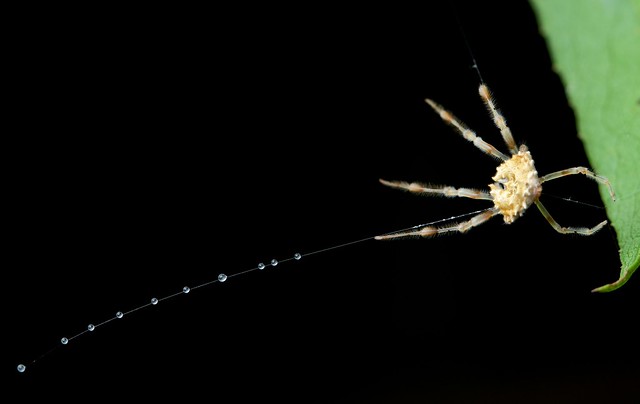
Bolas spider (Exechocentrus n.sp.) from Andasibe national park, Madagascar. Copyright Paul Bertner 2015.
As one might expect from such a peculiar spider, this is not the whole story. Left to chance alone, swinging a single line would be even less effective than casting a line without a fly or bait. However, studies have shown that bolas spiders, on average capture as much as their web building counterparts. How? With perfume. Or rather a sex pheromone. Normally the domain of sexually willing and available females, the pheromone is species specific, and entices male suitors. Wafting on the humid night air, the moths follow the concentration gradient with their ultra sensitive antennae until they reach the source. Once there, they will literally fly circles around the waiting spider, affording several attempts at capture before wising to the spider’s subterfuge. This aggressive chemical mimicry is even more complex than what it appears on the surface. Some bolas spider species (Mastiphora hutchinsoni among others) have been shown to emit pheromones for multiple moth species and adjust the concentration ratio in response to the scotophase (the stage of darkness in a light/dark cycle) and resultant activity pattern particular to each moth species. How such a complicated strategy has emerged is truly a wonder of nature. One hypothesis is that the pheromone analog is actually derived from a native pheromone used by the female bolas spider to attract the much smaller males, which would otherwise have difficulty finding her. However the mechanism behind the development of multiple pheromones and the ability to adjust their concentration ratios remains baffling.
Hunting strategies seem to vary between the three genera of Mastiphoreae. “Mastophora holds the bolas stationary with a front leg until a moth approaches, and then cocks the leg and swings the bolas towards the prey with a rapid pendulum-like stroke. Ordgarius begins to whirl the bolas rapidly when detecting an incoming moth. Cladomelea akermani whirls the bolas immediately after it is prepared for about 15 minutes, even when there is no moth present. Ordgarius sometimes has smaller droplets above the terminal one, whereas the other genera produce only one terminal globule.”(Unreferenced Wikepedia note).
Like most of the araneidae, bolas spiders have poor vision, instead relying on the vibrations from the beating wings which are picked up by pressure sensitive hairs (trichobothria) which line the legs. Once the bolas makes contact with the moth, the sticky globule(s) sink and spread over the scales preventing escape through their release. The spider then gently reels up its prey and will either feed or else tie up its prey with a different form of silk and produce a new bolas to continue hunting. On the occasions where hunting is unsuccessful, the line is brought in and consumed.
It would be interesting to trace the emergence of the bolas spiders and the selective pressures which have led to the secondary loss of a web building habitus. One might think that the ability to emit a species-specific pheromone evolved first and then the abundance of prey led to the dispensation of expensive silk production in a gradual and/or episodic evolution towards its current hunting strategy. However, this view is complicated by the the fact that standard webs are not effective at catching lepidopteran prey short of entanglement. The wings of butterflies and moths are covered in delicate overlapping scales which are readily dislodged upon even the slightest contact, something which is exacerbated with frantic flapping. Therefore when butterflies and moths fly into a web, the web adheres to the shed scales, enabling escape for the majority of subjects. This might indicate that the web building stratagem was lost first, followed only later by complex pheromone mimicry. This would imply stages in bolas development (or reduction in web design) were probably present at one point or another and that such a means of capture might have involved less specificity in terms of prey.
This wonderfully intriguing spider undoubtedly has more secrets to reveal though finding them might involve a bit of fishing.
Bolas spider in action begins at 3:00 (David Attenborough’s “Life in the undergrowth”.
Part III – The ground and understory dwelling spiders
Unlike the orbweavers, this group is comprised of ambush predators and active hunters. The former are characterized by prolonged stationary periods which facilitate photography of this group. They allow the time to set up a tripod, compose the photo and then take deep stacks to fully eke out the detail of a scene, possibly from several different angles. The Crab spiders exemplify this group.
Crab spiders

Crab spider with tetraponera ant prey and a kleptoparasitic fly (Michiliidae) drinking hemolyph. Photo from Udzungwa national park, Tanzania. Copyright Paul Bertner 2014.
Although most crab spiders are plain and cryptically coloured, others have gravitated in the opposite direction, bedecked in bright and beautiful colours that melt into equally gaudy flowers. Other species of interest have unusual morphological traits (like the Brazilian crab spider (Epicadus heterogaster)) or else enjoy protection/hunting advantage through mimicry and are rarer still.
Unlike the other arachnids mimics in the section below, crab spiders do not solely use their likeness to their model as a means of concealment (defensive mimicry), but also as a means of approaching their prey and taking their prey by surprise (offensive mimicry). This essentially means that each species of crab spider displays species-specific predation of their models.
One of the most impressive of these mimics is the gliding ant (Cephalotes sp.)-mimicking crab spider, Aphantochilus rogersi. With a range extending from Central to South America, its wide distribution is at odds with its low abundance. Mothers deposit their eggs within the vicinity of target nests so that young spiderlings don’t have far to travel to find food. Preying exclusively on Cephalotine ants, spiders employ several behaviours to minimize risk and confound their prey. This includes strategic attack from behind and raising the ants above their heads such that they are unable to potentially injure the spider. Prey are also held closely in a manner reminiscent of two ants communicating by trophollaxis. A paper outlining A. rogersi behaviour can be seen HERE.
When shooting crab spider mimics, choose an angle which shows the similarity between model and mimic and doesn’t obscure the details of either one. The photo below represents an early attempt, and could have been improved by angling the subject slightly so that it not only filled the frame more, but also didn’t appear so flat on the horizon. The colour balance has a distinctly yellow cast to it and a greater dof with focus stacking would have been an excellent option. The subject would have also benefited from additional diffusion, though the textured body helps dispel some of the specular highlights.

The turtle ant-mimicking crab spider (Aphantochilus rogersi) preys almost exclusively on the turtle ants it mimics. Photographed in Iwokrama nature reserve, Guyana. Copyright Paul Bertner 2012.

A dorsal view of the turtle ant-mimicking crab spider (Aphantochilus rogersi) illustrates even better the morphological similarities in body architecture. Photographed in Iwokrama nature reserve, Guyana. Copyright Paul Bertner 2012.
Compare the above predation with two ants engaging in legitimate trophollaxis below. Always think of potential pairing of photos, this is an especially relevant consideration when photographing models and mimics. The photos naturally complement one another and aid in the unfolding of a story which might be otherwise impossible to tell with a single photo.

Two gliding ants (Cephalotes atratus) engaging in trophollaxis. Photo taken in the Kanuku mountains, Guyana. Copyright Paul Bertner 2010.
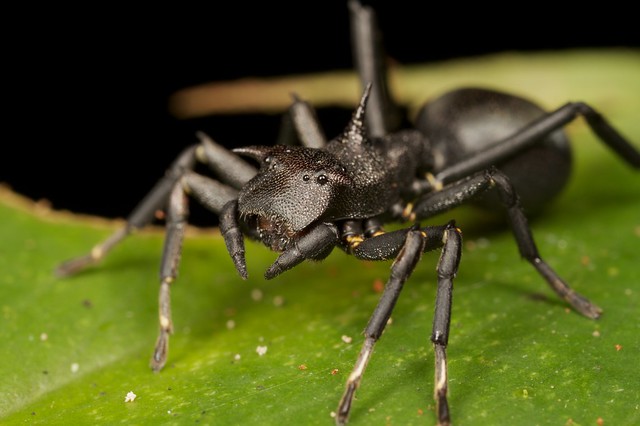
Cephalotes Ant mimicking spider (Aphantochilus rogersi). Photo taken in the Kanuku mountains, Guyana. Copyright Paul Bertner 2010.
This aggressive mimicry is more common amongst the crab spiders than other families, like the Corinnidae, which are more likely to employ defensive mimicry to avoid predation and/or parasitism.
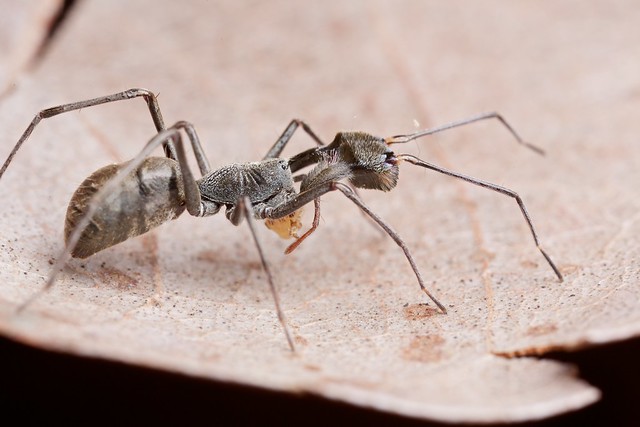
A diacamma ant-mimicking corinnid spider (Pranburia manahoppi). Note the furry foreleg segment which mimics the head of an ant. Photographed in Angkor Wat, Cambodia. Copyright Paul Bertner 2013.
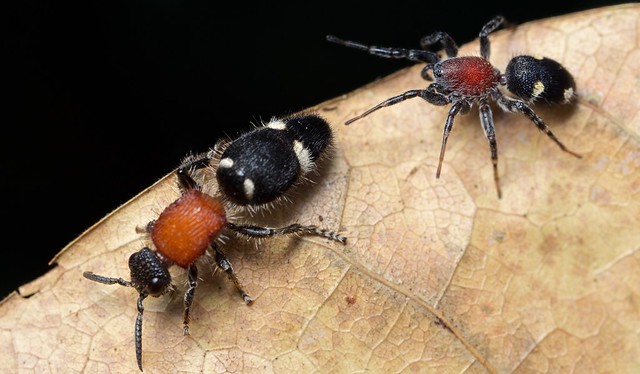
A velvet ant (model) and its spider mimic (Graptartia granulosa). Photographed in Uzungwa national park, Tanzania. Copyright Paul Bertner 2014.
[A much more in-depth picture of mimicry is outlined in the behaviour(s) section below]
One especially salient feature of crab spider behaviour that should be taken advantage of is their penchant for staking out flowers in the hopes of ensnaring nectar seeking insects. This can make for beautiful compositions, whether you choose a high magnification (thus creating colourful floral bokehs), or else choose a lower magnification and include the flowers in your composition. Moreover, camouflage is the order of the day complementary colours and uniformity of the colour palette can help create very aesthetic photos.

Crab spider with mosquito prey in zucchini flower. This 40 shot stack allowed me to detail the beautiful microenvironment of the spider, allowing the spider to almost disappear within the details. Photographed in British Columbia, Canada. Copyright Paul Bertner 2012.

A white Crab spider (Misumena vatia) with dolichopodinae (Condylostylus occidentalis) fly. Photographed in British Columbia, Canada. Copyright Paul Bertner 2012.

Crab spider (Misumenia vatia) with hoverfly on lavender inflorescence at sunset. Shot on a tripod, the background has an almost pastel look to it. Photographed in British Columbia, Canada. Copyright Paul Bertner 2012.
Since the colours can in fact be so similar, the spiders can sometimes blend in with the flowers making them difficult to differentiate. Try boosting contrast and adding additional sharpening to the edges of the spider to bring out details.

Camouflaged crab spider on hoya inflorescence. Photographed in Mt. Isarog national park, Philippines. Copyright Paul Bertner 2014.
Despite their apparent preference for flowers and the abundant insect fauna which frequents them, crab spiders can also be found in the leaf litter, or blending in amongst the lichens and mosses and bark on a tree trunk.

Crab spider camouflaged on tree trunk. Photographed in Cuc Phuong national park, Vietnam. Copyright Paul Bertner 2013.
Another interesting feature is the presence of UV reflectance in many crab spider species. Initially the notion that crab spiders reflected UV light seemed at odds with their cryptic colouration and positions nestled within flowers. Since insects see in the ultratviolet spectrum, scientists were at a loss to explain the supposedly conflicting principles of crypsis and openness . However, it soon emerged that like the UV fluorescent nectar guides which act as an attractant indicating the location of nutrient rich nectar, the UV visible spiders could be attracting nectar seeking insects with false promises.

Crab spider under UV light. Photographed in Udzungwa national park, Tanzania. Copyright Paul Bertner 2014.
Two-tailed spider (Hersiliidae)

Two-tailed spider (Hersiliidae) on lichen covered tree trunk. Photographed in Andasibe national park, Madagascar. Copyright Paul Bertner 2015.
Mostly stationary, I find these long-legged spiders a challenge to photograph well, and often it is only within the confines of a nice background (like the one above) that I am able to achieve a satisfactory photo. Otherwise, the majority of photos wind up looking like the one below. Since two-tailed spiders are pretty much confined to a single tree, it is possible to maneuver them onto nicer, more aesthetic backgrounds with risking them jumping off the tree and and being lost. Just be careful to direct them downwards rather than out of reach.
Although technically fine, the centre-weighted composition, and symmetry make the below image a little dull. Like when photographing other long-legged species like harvestmen, one typically needs to frame or crop out the legs in order to achieve decent magnification and detail.

Pink two-tailed spider (Hersiliidae) from Andasibe-Mantadia national park, Madagascar. Copyright Paul Bertner 2011.
Photographing behaviour can undoubtedly add interest, however I find it is only the second image which is really dynamic enough to capture my interest. The detail on the web-bound prey, the pose and out of focus predator are all preferable to the documentarian aspect portrayed in the first image.
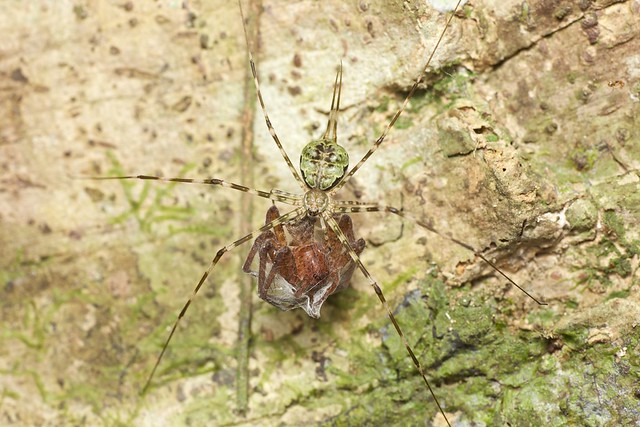
Two-tailed spider (Hersiliidae) with huntsman spider prey. Photographed in Khao Yai national park, Thailand. Copyright Paul Bertner 2013.
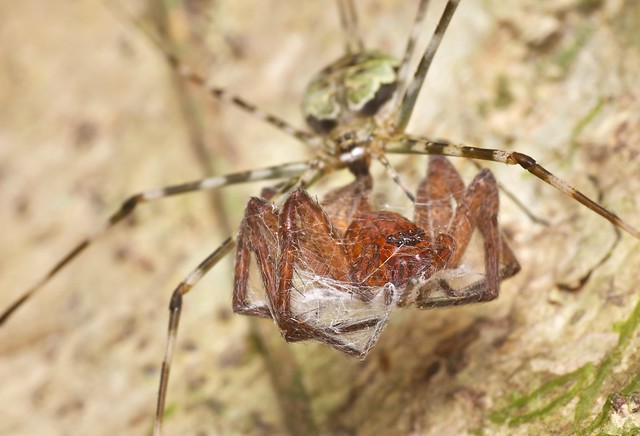
This was kind of an odd shot. It is a two shot de-focus stack ie. I used focus stacking software, only I loaded one image where the huntsman spider was in focus and one image where the two-tailed spider was out of focus. Then I focus painted the eyes and body to create a greater degree of separation between the two subjects for a smoother bokeh. Two-tailed spider (Hersiliidae) with huntsman spider prey. Photographed in Khao Yai national park, Thailand. Copyright Paul Bertner 2013.
Huntsman spiders (Sparassidae)
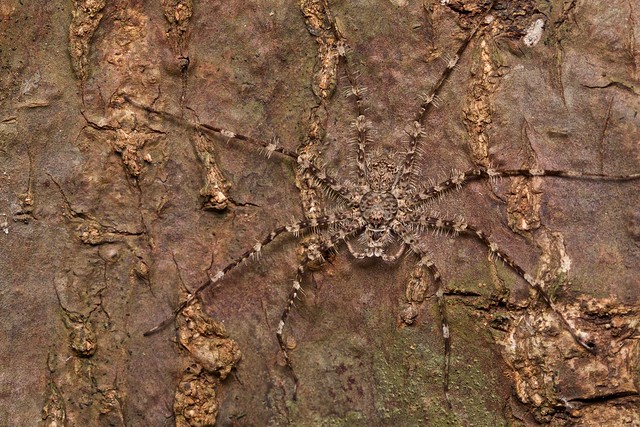
Lichen huntsman spider (Pandercetes sp.). Photographed in Udzungwa national park, Tanzania. Copyright Paul Bertner 2014.
Huntsman spiders as the name would suggest are true hunting spiders. Their long legs help them to chase down and ensnare prey. There are quite a few genera but some of the most common and photogenic are Pandercetes, and Heteropoda, the so-called lichen huntsman spiders. These spiders tend to be tree-huggers, splaying their hairy legs which are outfitted with spines and irregular tufts of hair which help to break up their outline, thereby enhancing camouflage.They seldom move, and if disturbed they usually don’t go far, simply running to the other side of the tree trunk. In some cases their flattened bodies may help them fully or partially wedge themselves into crevices in the bark. Fortunately because they hug their substrate so tightly there are generally few shadows. This combined with their overall pilosity makes even lighting not too difficult to achieve. Their large leg span and splayed position at rest can sometimes make composition a little tricky. Consider several different framing positions or crops in PP.
The two shots below are your standard portrait. However, by framing the second shot vertically which one doesn’t normally see in these kinds of portraits, the shot comes across as more dynamic. What I like is that there is a nicer flow or “eye-sweep” from the in focus lower part of the photo to the upper part. Compare this to the horizontal presentation and the eyes naturally focus only on the centre of the image and may go left or right, but not in any kind of natural flow but more in hectic back and forth.

Lichen huntsman spider (Pandercetes sp.) portrait. Photographed in Udzungwa national park, Tanzania. Copyright Paul Bertner 2014.

Lichen huntsman spider (Pandercetes sp.) portrait. Perhaps slightly more room on the left hand of the frame would have made for an even better composition. Photographed in Udzungwa national park, Tanzania. Copyright Paul Bertner 2014.
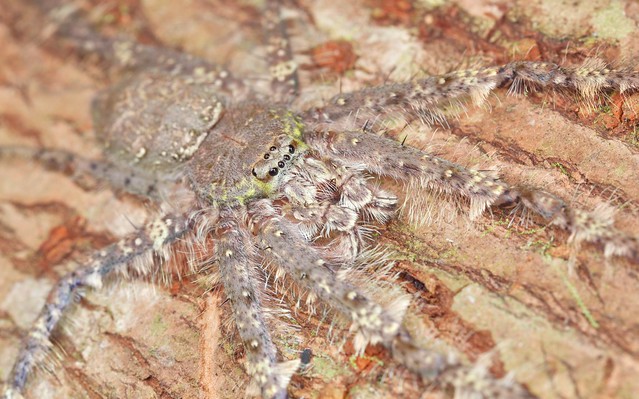
Lichen huntsman spider (Pandercetes sp.). This shot lacks contrast, and therefore falls a little flat compared to the above portrait. Photographed in Mt. Isarog national park, Philippines. Copyright Paul Bertner 2014.
Egg sacs differ quite considerably between species. While some mothers attach their egg-sac to a tree and weave in mosses and debris as camouflage, other make pendulous sacs on the margins of leaves or the ends of branches.

Lichen huntsman spider (Pandercetes sp.) mother guarding egg sac. Photographed in Danum Valley Conservation Area, Borneo. Copyright Paul Bertner 2014.
Others still, guard them closely by holding them underneath their bodies under their pedipalps.
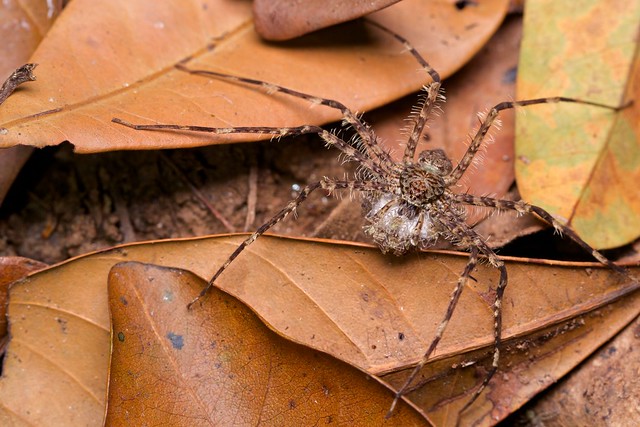
A mother lichen huntsman spider carrying a hatching egg case. Photographed in Udzungwa national park, Tanzania. Copyright Paul Bertner 2014.

A mother lichen huntsman spider carrying a hatching egg case. Photographed in Udzungwa national park, Tanzania. Copyright Paul Bertner 2014.

A mother lichen huntsman spider carrying a hatching egg case. Photographed in Udzungwa national park, Tanzania. Copyright Paul Bertner 2014.
When photographing ‘active behaviour’ like hatching egg sacs and predation I seldom can predict which angle I will like most, which means I rarely shoot focus stacks of active behaviours unless I am absolutely certain it is a winner. Moving subjects also make stacking problematic, and time consuming to repair in post processing, though not impossible. Therefore I am constantly in motion, shooting from every possible angle and magnification I can think of, adjusting the position of my flashes to provide either even illumination or else dramatic lighting. I will backlight and blacklight. The initial moment of predation are essential! This is when the prey struggles and unique postures and positions can be shot like the proboscis of the moth below. Although I didn’t see the attack, I knew I’d gotten there only briefly after because the moth still fluttered and the proboscis would curl and uncurl. After the initial struggle, the prey’s death will mean that the spider will settle into a more comfortable position to feed. While still interesting, there is less potential to capture that really strong image.

Huntsman spider with moth prey. Photographed in Udzungwa national park, Tanzania. Copyright Paul Bertner 2014.
I was lucky enough to catch the beginning of this second encounter. The huntsman spider was tilting its head from side to side in a rocking manner in order to drive its chelicera through the hard body of the harvestman. The interesting pose, lovely colours and and interesting scene make this an enjoyable photo.
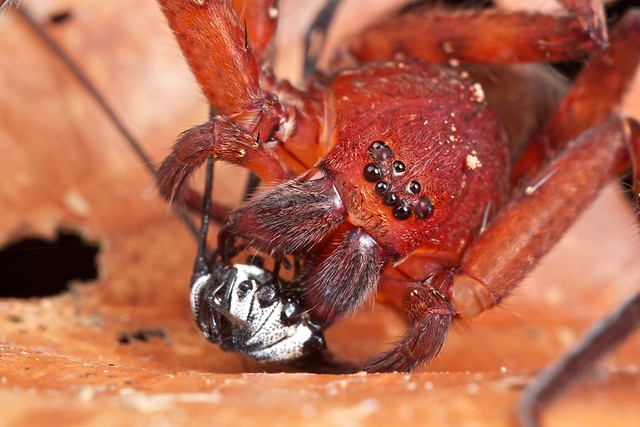
Orange huntsman spider with jewelled harvestman prey. Photographed in Danum Valley Conservation Area, Borneo. Copyright Paul Bertner 2014.
Some species display remarkably vivid colouration, like the aptly name Heteropoda davidbowie or Madagascar’s Megaloremmius leo.
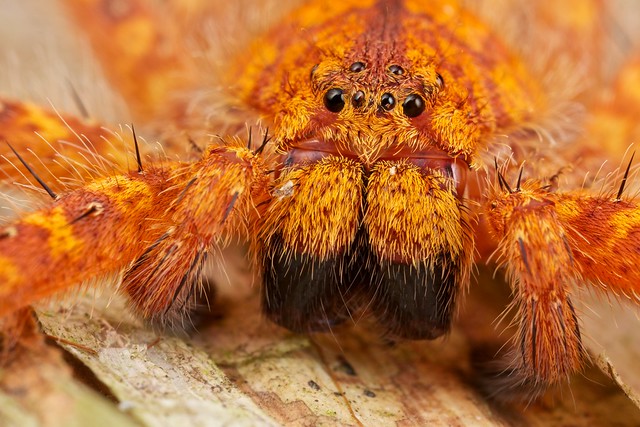
Orange huntsman spider (Heteropoda davidbowie). Photographed in Danum Valley Conservation Area, Borneo. Copyright Paul Bertner 2014.
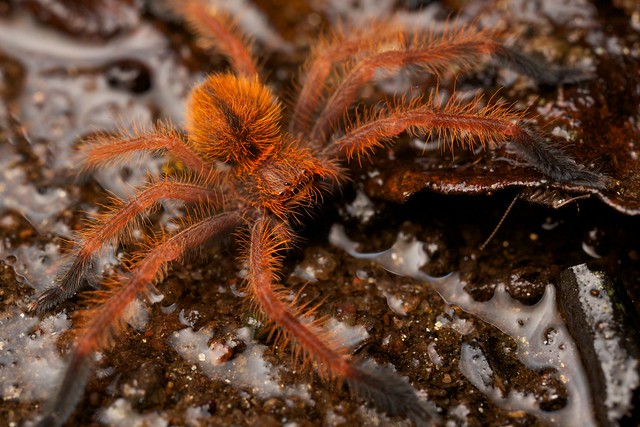
Hairy orange huntsman spider (Megaloremmius leo). Photographed in Ranomafana national park, Madagascar. Copyright Paul Bertner 2015.
Others can appear translucent green, almost disappearing entirely when viewed from below with the sun backlighting the leaves. This can potentially make them good candidates for backlighting. Although in this particular instance, I preferred the non-backlit version.
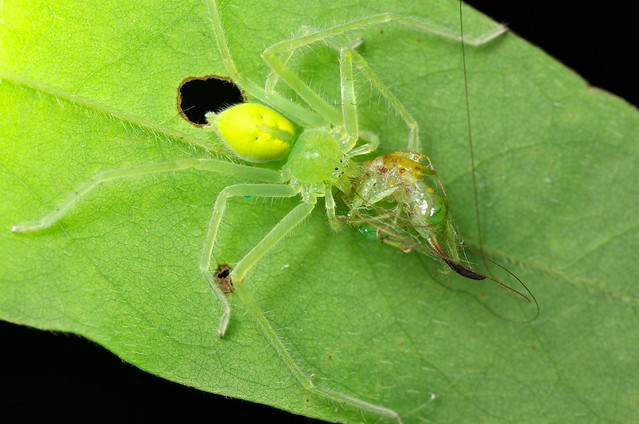
Green huntsman spider with katydid prey. Compared to the above photo of the huntsman with the moth, the ‘long- dead’ katydid is notably less interesting. Photographed in Udzungwa national park, Tanzania. Copyright Paul Bertner 2014.
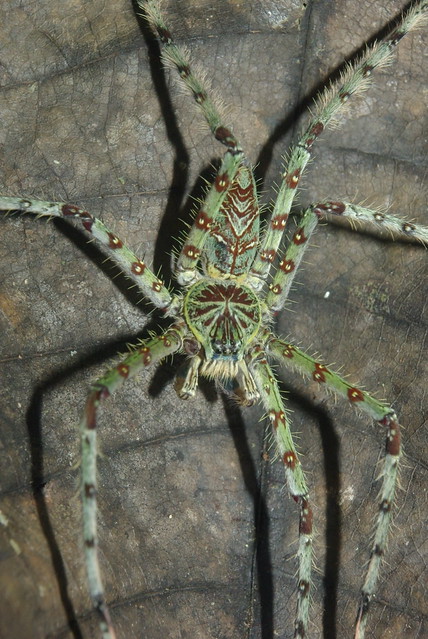
Brown ringed huntsman spider (Heteropoda boiei). Photographed in Lambir hills national park, Borneo. Copyright Paul Bertner 2010.
Perhaps one of the most interesting huntsman that I have encountered is the large hairy lichen huntsman from Maliau Basin. Possibly more arboreal than other species of the genus or else endemic to the region, because I have only ever seen it once and have not found any online records.
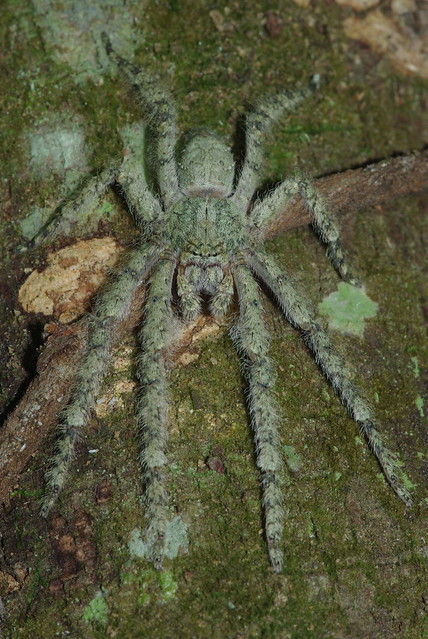
Hairy lichen huntsman (Heteropoda sp.?). Photographed in Maliau basin, Borneo. Copyright Paul Bertner 2010.
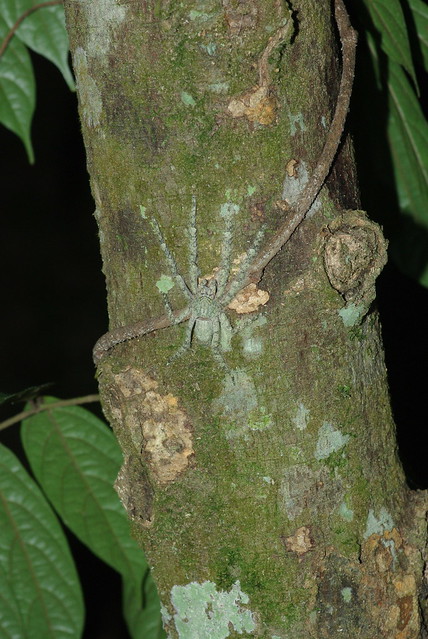
Providing a bit of space shows the size, as well as the excellent camouflage of this rare and interesting species (Heteropoda sp.?). Photographed in Maliau basin, Borneo. Copyright Paul Bertner 2010.

Lichen huntsman spider (Pandercetes sp.). The white patches of hair are particularly interesting since they have a curlicue shape rather than the straight form of standard hairs and bristles, a form which is more consistent with a lichen or fungal patch on a tree. Photographed in Danum Valley Conservation Area, Borneo. Copyright Paul Bertner 2015.

Not the greatest closeup of this Lichen huntsman spider (Pandercetes sp.). However, it illustrates in greater detail how the white patches of hair are particularly interesting since they have a curlicue shape rather than the straight form of standard hairs and bristles, a form which is more consistent with a lichen or fungal patch on a tree. Photographed in Danum Valley Conservation Area, Borneo. Copyright Paul Bertner 2015.

Lichen huntsman spider (Pandercetes sp.). Photographed in Khao Yai national park, Thailand. Copyright Paul Bertner 2013.
Taking the concealment game to an even higher level is one of the most well camouflaged huntsman I have ever encountered and by some accounts a new species. The photos below show just how effectively the hairs can disrupt their form. I only regret not sticking around and taking daytime in situ natural light shots including some more background to really drive the point home.

A new species of huntsman spider hugging a thin branch. Initially there was only the single branch, however I felt that the image would be stronger for comparative purposes if I held another branch within the frame .Photographed in Udzungwa national park, Tanzania. Copyright Paul Bertner 2014.

A new species of huntsman spider. The legs and circumference of the abdomen are especially pilose, aiding in the disappearing act that we see. Only when the legs and body are somewhat separated from the substrate does the actual form begin to emerge. Photographed in Udzungwa national park, Tanzania. Copyright Paul Bertner 2014.
Lynx spiders (Oxyopidae)

Many lynx spiders can display beautifully vivid colouration or various degrees of translucence. Photographed in Danum Valley Conservation Area, Borneo. Copyright Paul Bertner 2014.
Lynx spiders tend to be exhibit a mixed hunting strategy. Although many can be found on leaves and flowers ambushing pollinators much the same as crab spiders, they are also very quick and can run down prey should their initial attack prove unsuccessful. While they will often sit still for long enough to shoot stacks, they are also more sensitive than the groups treated so far, and they will readily jump from their perch to the ground where they will often be lost to the undergrowth.
I have found that my shooting strategy differs depending on whether I am in the forest or out in the open. In the open lynx spiders typically occupy long, thin grass blades, plant leaves and the occasional inflorescence. Because there is more wind in this open environment, I will either freehand or deploy the tripod, but only as a stabilizer to lean on and reduce shake, rather than attaching the camera. Alternatively one can use a sturdy walking stick or pole to loop your arm around to provide support. This offers more shooting flexibility with the swaying grasses and plants. Alternatively if you want to chance it you can always clamp the base and/or tip of the plant to reduce sway. However, this always comes with the risk of scaring off the subject. I will shoot with large apertures to take advantage of a smooth bokeh and capture a dreamier feel. Shutter speed and ISO evidently depend on the lighting conditions, but something like 1/60 and ISO 400-800 would be typical.
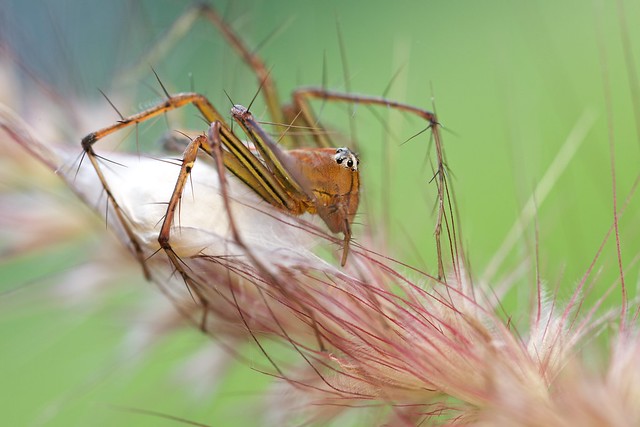
A female lynx spider on a flowering grass stalk guarding egg sac. Photographed in Angkor Wat, Cambodia. Copyright Paul Bertner 2013.
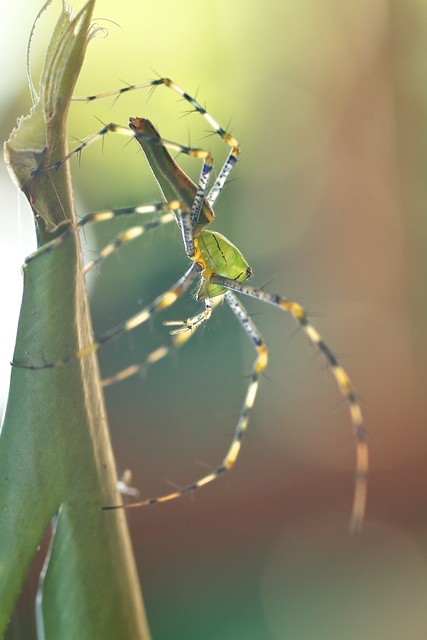
Lynx spider (Peucetia sp.) with fill flash and natural light at sunset. A little backlighting also helps show off the translucent sections of the legs. Photographed in Marojejy national park, Madagascar. Copyright Paul Bertner 2012.
In the forest I shoot mostly with flash, since little light penetrates the understory and even shooting upwards to capture as much light as possible still requires relatively high ISOs and what’s the use of a beautiful bokeh if it’s marred by excessive noise? Understory plant matter can be quite dense and intertwined and I find that more often than not that while setting up, I’ll disturb a vine of plant runner which is attached to the plant on which the subject is resting causing it to move and often lose the subject. Instead where possible I try to shoot downwards to capture the substrate as background. Lynx spiders will often hover or perch above the substrate on their long legs rather than hunker down and wrap their legs around them (there are exceptions). This provides the benefit of bouncing the flash underneath the subject to eliminate shadows, providing more detail. One technique that I’m working on is bouncing the flash underneath the body but above the substrate so that only the thin legs are backlit, rather than the substrate and thicker body. I’ll report back here if I can get any good results.
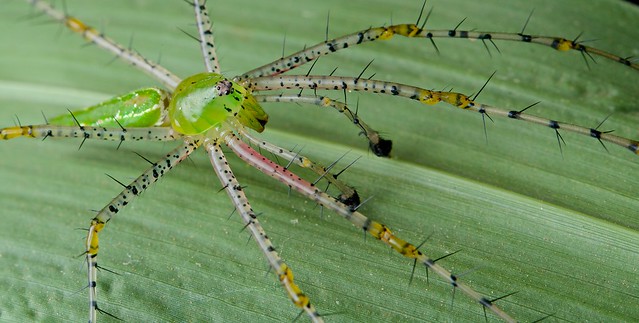
Lynx spider (Peucetia sp.). Photographed in Udzungwa national park, Tanzania. Copyright Paul Bertner 2014.

Tilting it’s abdomen upwards, a strand of silk is released from the spinnerets which can then catch the wind and sweep the spider into an uncontrolled flight known as ballooning. This is a common form of transport, especially for spiderlings and smaller species. Bird dung-mimicking lynx spider. Photographed in Angkor Wat, Cambodia. Copyright Paul Bertner 2013.
The combination of feeding and the maternal instinct of guarding her egg sac made this individual particularly sedentary and thus amenable to focus stacking.
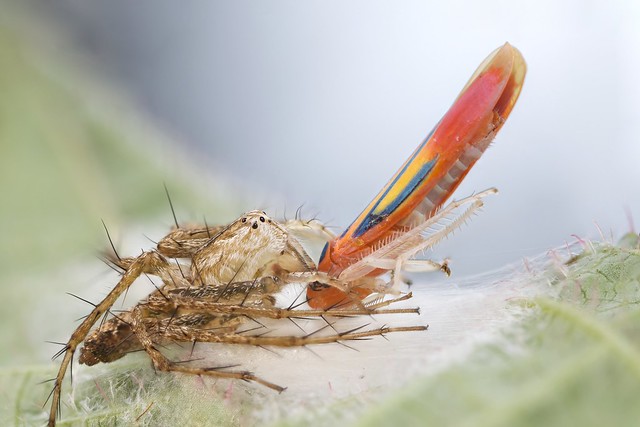
Lynx spider with cicadellid prey focus stack. Photographed in Mananara-Nord national park, Madagascar. Copyright Paul Bertner 2012.
On the other hand, this lynx spider with iridescent wasp was less approachable. I certainly wanted to display its beautiful catch to full effect. Unfortunately my diffusion wasn’t great here, and I could have slightly increased the flash power. However, I did manage to a shoot a 2 shot stack to get both the prey and spider in focus…tradeoffs.

Lynx spider with jeweled cockroach wasp prey focus stack. Photographed in Danum Valley Conservation Area, Borneo. Copyright Paul Bertner 2014.
Ground spiders (Zodariidae)

Ground spider (Zodariidae) with carpenter ant (Camponotus sp.) prey. Photographed in Udzungwa national park, Tanzania. Copyright Paul Bertner 2014.
Many Zodariid spiders are ant-mimics and are generally treated as conspecifics despite the fact that physically they bear only a passing resemblance to their ant models. This imperfect mimicry is due to the nature of the selective pressures (eg. poor eyesight of the model species and predators). Their ability to camouflage themselves as colony nest mates lies in a collaboration of behavioural and chemical mimicry. With respect to the former, the spiders seem to be able to communicate in a manner which appeases their ant model. This seems to be orchestrated through a combination of tactile and chemical cues.
——-
“For example, Habronestes bradleyi waves its front legs around when hunting and, when the legs are amputated, the spider has a difficult time locating ant prey suggesting that the spider may have organs on its front legs that pick up chemical cues from ants. When these spiders detect chemical cues left by ants, they adopt prey capture posture and behavior . Zodariid spiders in the genus Zodarion have a structure on the dorsolateral distal tip of the first femora called the femoral organ. The organ consists of pores surrounded by specialized setae with secretory cells beneath the cuticle . It is hypothesized that the femoral organ may release chemicals that somehow subdue the ants upon which the spiders prey (the setae may facilitate dispersion of the secretion) . Zodarion rubidum Simon (and other species in the genus) move their front legs around while moving through the environment, similar to the antennal illusion of myrmecomorphs. The spiders seem to use the legs (perhaps via the femoral organs) to pick up cues about ants and conspecifics the spiders may encounter. Recent work by Pekár and Jiroš tested whether various species of myrmecomorphs including one myrmecophage, Zodarion alacre (Simon), were also chemical mimics of ants. They found little overlap in the chemical signature of the spiders and ants. Only a weak similarity in profiles was seen for the myrmecophage. The authors hypothesized that the femoral organ of Zodarion may be used to synthesize the compounds responsible for the similarity.
“When they attack, Zodariids typically attack quickly from the rear of an ant, bite a leg, retreat, and may repeat this sequence several times until the ant is paralyzed. The spider then lifts the moribund ant and carries it to a secluded place to feed. It has been suggested that the paralyzed ant is used as a shield and a decoy to protect the zodariid from attacks by living ants; the paralyzed ant provides pheromone cues to a curious worker ant that passes by and may provide tactile cues as well ” —Journal link
——
Generally found on low lying leaves, plant stems, or the ground, these smooth and shiny spiders require proper diffusion for the best results. They should also be approached with some degree of stealth, otherwise they are liable to drop their prey and not return.

Ground spider (Zodariidae) with carpenter ant (Camponotus sp.) prey. Photographed in Udzungwa national park, Tanzania. Copyright Paul Bertner 2014.

Ground spider (Zodariidae) with matabele ant (Megaponera analis.) prey and kleptoparasitic fly (Michiliidae). Photographed in Udzungwa national park, Tanzania. Copyright Paul Bertner 2014.

Ground spider (Zodariidae) portrait showing huge boxer-like pedipalps. Photographed in Cat tien national park, Vietnam. Copyright Paul Bertner 2013.
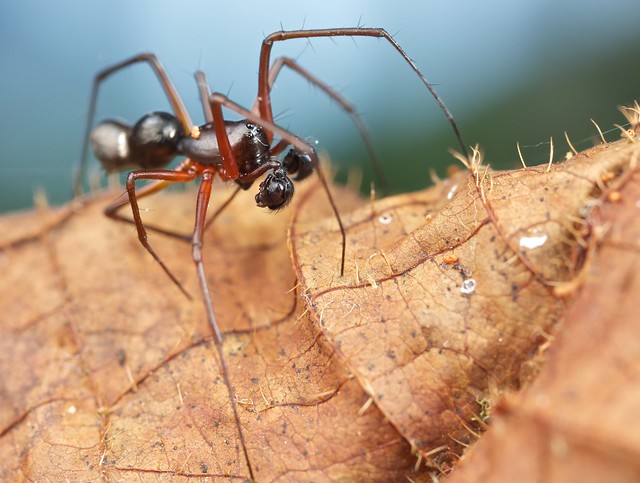
Ant-mimicking ground spider (Zodariidae) showing pedipalps that look like ant heads. Photographed in Mt. Kinabalu national park, Borneo. Copyright Paul Bertner 2013.
Cryptothele (This genus was moved from their own family, the Cryptothelidae, to the Zodariidae in 2006)
Cryptothele sundaica is the only recorded species I could find from Borneo. However, all the photos I have seen from that species show it to be a cryptic ground species that is a mud mimic. This individual was found on a mossy tree trunk and is obviously designed and capable of blending into that environment. Therefore this probably represents a new species.
Photographing such a cryptic species had to involve not just closeups but widening the scene to shoot it in its environment.
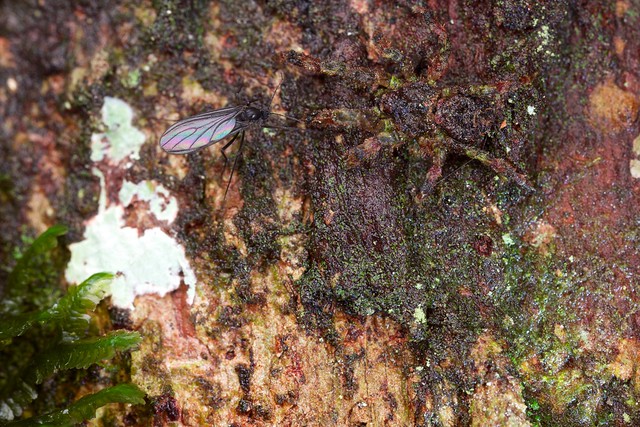
Unidentified Cryptothele sp. seen stalking a fly and showing its remarkable camouflage. Photographed in Mt.Kinaballu national park, Borneo. Copyright Paul Bertner 2014.

Unidentified Cryptothele sp. Photographed in Mt.Kinaballu national park, Borneo. Copyright Paul Bertner 2014.
Tarantulas (Mygalomorpha)

Black and olive baboon tarantula (Encyocratella olivacea). Photo from Amani nature reserve, Tanzania. Copyright Paul Bertner 2014.
Tarantulas epitomize the big, hairy bump in the night that frightens arachnophobes the world over. However, they are more commonly of the gentle giant variety rather than the terrors run amok in the style of old school Japanese horror films. Although quite quick when disturbed, generally they move quite ponderously, making them accommodating models. Although blacks and browns seem to be the preferred livery of most species, some few are dressed in iridescence, or interesting colours and banding patterns. The key is typically to get low and shoot upwards. An emotional response, wether it be joy, anger, awe or fear will make a photo more memorable and impactful. Therefore, it is that kind of primordial fear of spiders that is skulking around somewhere in even the most stalwart of us that I hope to unearth. By having the subject moving into the camera rather than away, baring its fangs or otherwise appearing to crawl out of the photo and towards the observer. An interaction is essentially what I’m after. I think Piotr Naskrecki’s amazing wide angle shot of the Goliath bird eating spider (Theraphosa blondi) is the photo that I’ve had in mind but have never had the skills or opportunity to execute; it is truly a masterpiece and can be seen here. My humble offerings are below.

Black and olive baboon tarantula (Encyocratella olivacea). Photo from Amani nature reserve, Tanzania. Copyright Paul Bertner 2014.
Many tarantulas are ground dwelling, making their burrows in the sides of embankments, though there are also those that have tree burrows, or have tied together mosses and lichens to form a shallow, but perfectly camouflaged retreat.
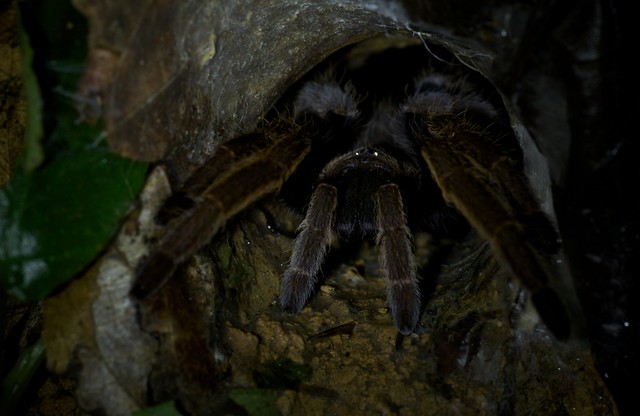
Tarantula emerging from burrow. By shooting solely by flashlight, I hope to evoke fear-based associations and therefore provoke an emotional response. Photographed in Gunung Leuser national park, Indonesia. Copyright Paul Bertner 2013.
Capturing them as they are climbing over obstacles results in more interesting poses than when they are at rest, so use a quick shutter (during the day) and fast flash speed if at night. You can sharpen the edge-hairs on the legs to really accentuate the texture of the subject and one of their chief distinguishing features. By provoking them a little it is also possible to photograph the jaws as they rear up in a defensive posture. They are almost exclusively nocturnal, yet another reason to try night hikes.
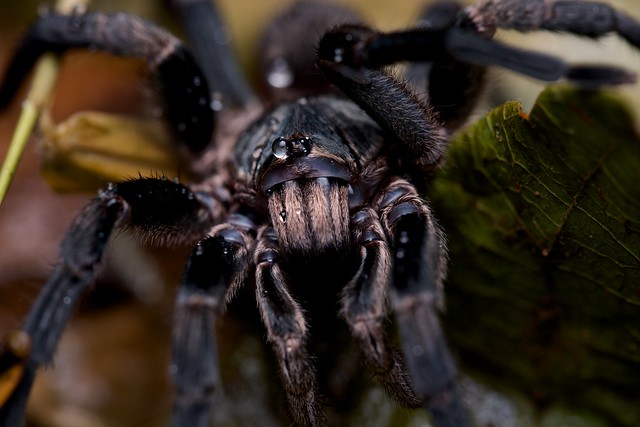
Tarantula (Ceratogyrus sp.). Photographed in Udzungwa national park, Tanzania. Copyright Paul Bertner 2014.
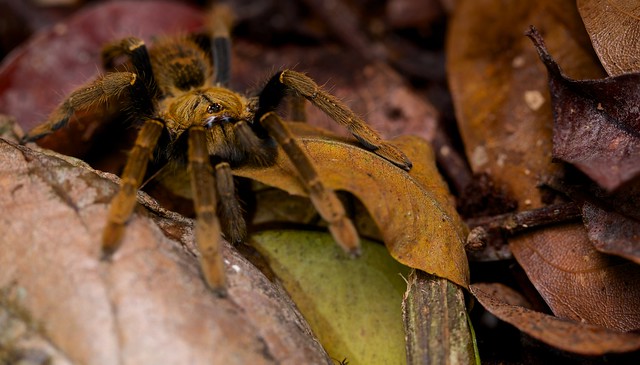
Black and olive baboon tarantula (Encyocratella olivacea). Photo from Amani nature reserve, Tanzania. Copyright Paul Bertner 2014.
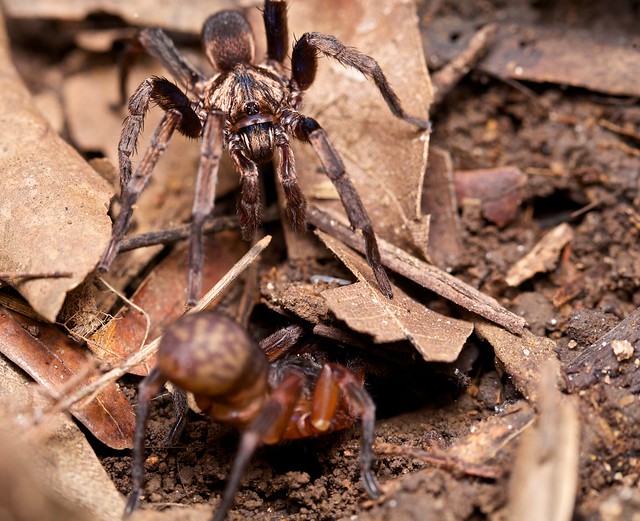
Male and female trapdoor spiders with female entering burrow. Photo from Amani nature reserve, Tanzania. Copyright Paul Bertner 2014.
Part IV – Predators
1) Araneophagic spiders
A) Pirate spiders (Mimetidae)
The pirate spider, not a web builder itself, emerges from a simple silken retreat or pad on which it rests during the day. It has wandered several plants already, but has not yet found what it’s looking for. Occasionally waving its long legs, it tests the air. What it’s looking for are the gossamer strands of another web, a thread which it can follow to its maker, and her next meal. Another few hours pass before she comes across a taught thread. She gently plucks at the foreign web, either mimicking an insect’s struggles, or else a lover’s romantic overture. There is no response. Alerted to a foreign presence the spider at the web’s centre draws its legs inward, creating tension so as to better interpret the vibrational cues. She isn’t quite sure how to interpret the vibrations and so she remains quiet. All the while the Mimetid has altered her tune, playing now faster, now slower, then waiting once more. Minutes pass like this until finally she receives a response. She has hit on the pattern which has provoked a programmed stereotyped response in the web builder, now become the prey. It is an invitation. Slowly, stealthily she approaches the web’s inhabitant until her long spiny legs encircle the other spider. Then all of a sudden the legs clamp down, the spines immobilize the victim and the mimetid lands a bite. The prey still struggles and so another bite is administered. A few moments pass, the struggles becoming feebler and feebler until finally they stop altogether. The mimetid drags her meal onto a corner of the web where she feels comfortable and then feeds.
Photographing pirate spiders is straight forward, their legs curve inwards making them sit comfortably within the frame while allowing good magnification of the head and rest of the body. Whether they are holding an egg sac in their jaws, or another spider, they are fairly patient and do not readily relinquish either. Witnessing actual hunting is not especially common unless you note the location of a spider beforehand and follow it. However, one can fairly frequently come across a mimetid with prey or eggs.
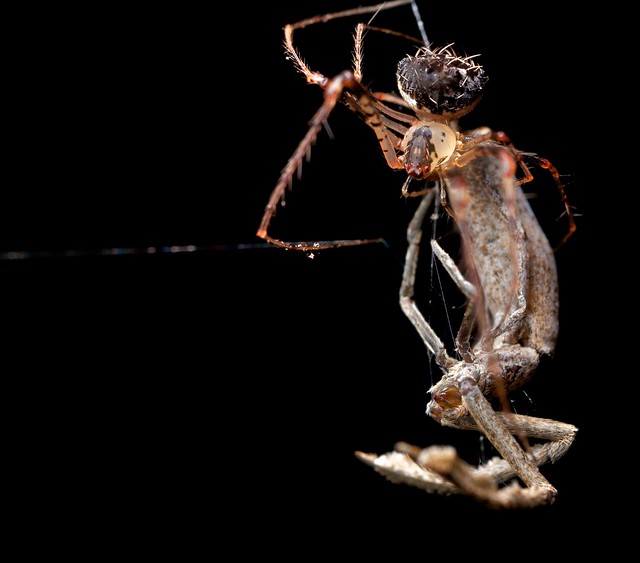
Pirate spider (Mimetidae) with uloborid spider prey. Photo from Udzungwa national park, Tanzania. Copyright Paul Bertner 2014.
B) Portia
Unfortunately I have only come across a handful of these remarkable spiders and most of those were before I began serious photography. However, as jumping spiders, the same general rules apply. Portias are a little slower, and considered in their movement. They also appear as detritus, and so one might ease off on the magnification and shoot them dorsally against a background of leaves or other sources of potential camouflage. Behaviour is fascinating in this genus and so given the chance you should follow them around for a bit and see just what they’re up to.

Portia labiata spider. Photographed in Gunung Leuser national park, Indonesia. Copyright Paul Bertner 2013.
C) The Spider Assassins (Archaeidae)
These strange spiders go by a variety of names which reflect their form and behaviour, though they are most commonly referred to as spider assassins and pelican spiders. The former epithet refers to their araneophagic diet, while the latter pays homage to their morphologically unique ‘necks’ (actually an extension of the cephalothorax). Despite the natural interest which these spiders garner by their looks alone, little is known about their natural history which can be explained by a variety of factors; their diminutive size (2-8 mm), nocturnal habits, location under foliage suspended head down, or by their short-range endemism. Not to mention that their cryptic colouration, browns and greys, which facilitate their camouflage as they drop evasively to the leaf litter. As a result, these spiders are poorly represented in the scientific literature, leaving it up to the imagination of the reader or better yet, the observer to fill in the details of their lives.
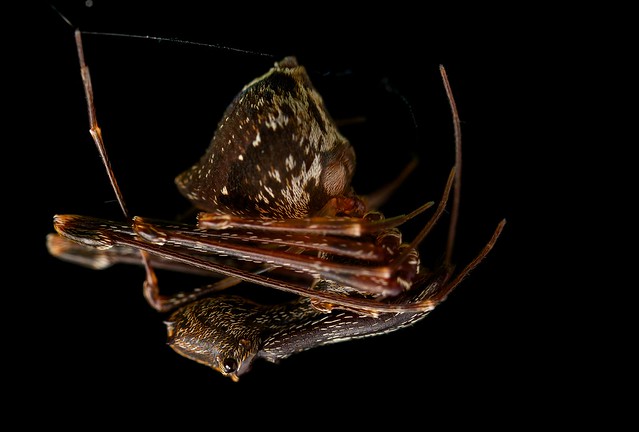
Spider assassin (Eriauchenius sp.) displaying typical head down behaviour found in situ. Photo taken in Andasibe national park, Madagascar. Copyright Paul Bertner 2015.
Perhaps the most striking features of this family are the elongated ‘neck’ and slender chelicerae (jaws) with recursive fangs, which together with the head comprise the seemingly teetering cephalothorax. Of note are also the long delicate legs with modified tarsi that enable the legs to extend beyond even the chelicerae. Each of these features; however seemingly bizarre has a specific purpose essential to its predatory, araneophagic diet. The aptly named spider assassin, nomadic in nature and lacking a web of its own can often be found in the leaf litter foraging for prey. As it navigates this landscape, the spider assassin is particularly attuned to finding the draglines of other spiders (a silken line which serves as a safety line) by mechano- and perhaps chemosensory means. With its long forelegs, it traces the path like a skilled hunter until it happens upon its hapless prey and spears it with its long forceps-like chelicerae.
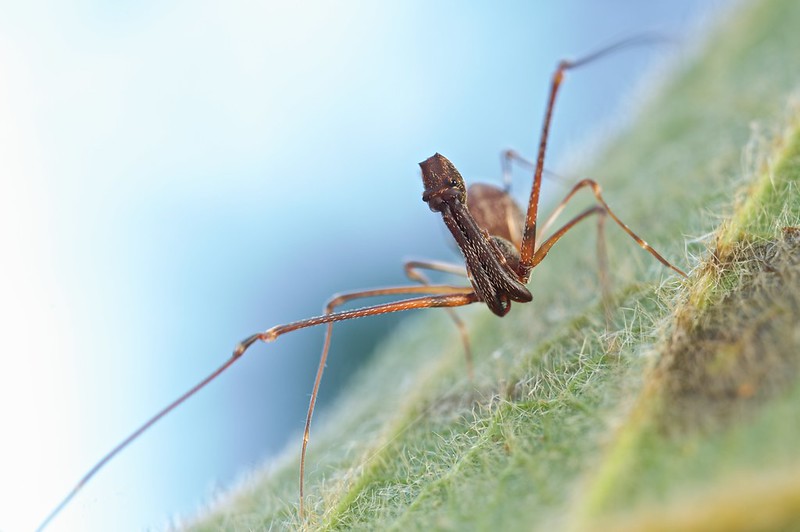
An anterior view of a spider assassin (Eriauchenius sp.) which shows to best advantage the long, thin legs and recursive jaws, morphological adaptations to its araneophagic diet. Diurnal encounters with Archaeidae are quite uncommon, and most are found at night, hanging by a silken dragline underneath leaves. Photo taken in Andasibe national park, Madagascar. Copyright Paul Bertner 2015.
Due to the relatively poor eyesight of most Araneomorphs, the Archaeid is able to approach within striking distance without alerting its prey. Thanks to its disproportionately long chelicerae, it impales its prey without exposing itself to collateral damage. Able to move both horizontally and vertically, the jaws close upon the prey like a vice. The fangs pierce the exoskeleton, and venom is pumped into the other spider. As the poison circulates in the hemolymph, the prey struggles even more violently but the hooked fangs remain embedded. Next, in a still unexplained behaviour, one chelicera lowers 90 degrees in a stereotyped action. Meanwhile the other chelicera holds the prey at a safe distance as it continues to thrash about in its death throes. Minutes pass and the struggling becomes weaker and weaker until it stops entirely. There may be a sporadic jerk, autonomic neurons releasing their final action potentials. But it is now safe to consume. The Archaeid lowers its meal to its mouth and feeds. The proteolytic enzymes in the venom have had time to work, and have broken down the internal organs, rendering them sufficiently liquid to imbibe.
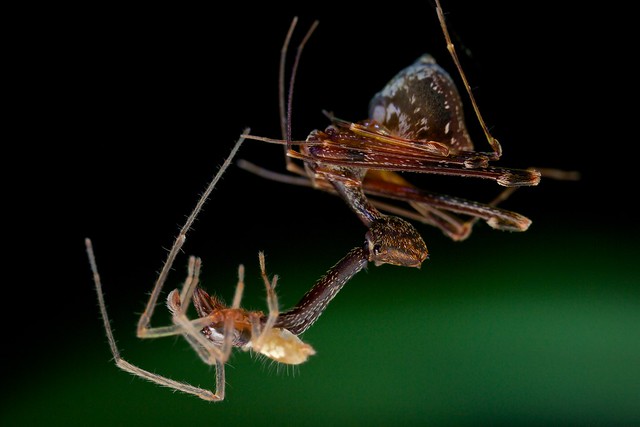
Eriauchenius sp. with prey. Photo taken in Andasibe national park, Madagascar. Copyright Paul Bertner 2015.
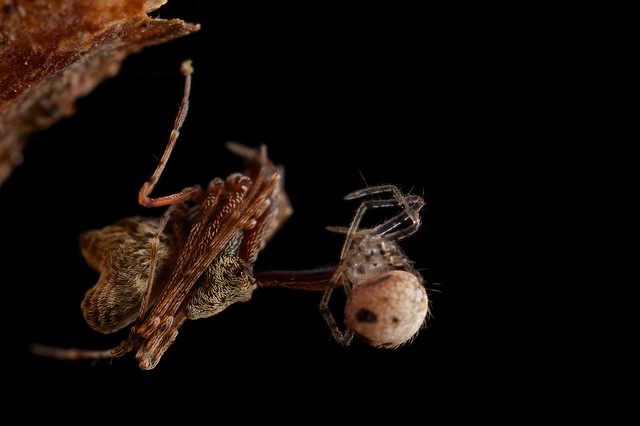
The distinctive abdomen with an almost bilobed appearance is an easily recognizable feature distinguishing Eriauchenius jeanneli, seen here with prey. E. jeanneli is one of the smaller sp. within the graciolis group. Photo taken in Andasibe national park, Madagascar. Copyright Paul Bertner 2015.
The below photo represents the only evidence (to my knowledge) of cannibalism within the Archaeidae. However, this behaviour should come as no surprise, as many groups within the Arachnids do engage in this behaviour.
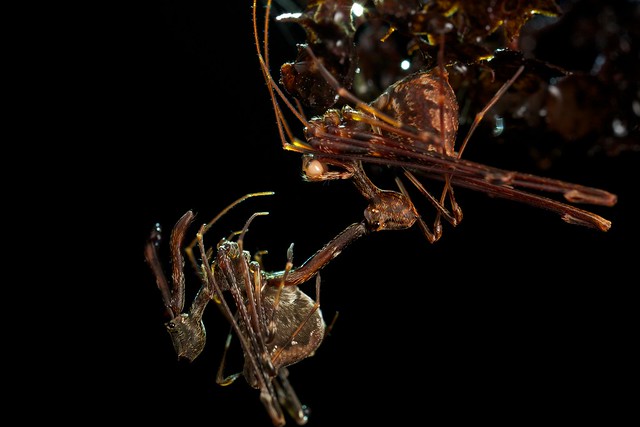
Spider assassin (Eriauchenius sp.) cannibalism. Photo taken in Maromizaha special reserve, Madagascar. Copyright Paul Bertner 2015.
Even more poorly understood is the courtship and mating behaviour of Archaeids. The extent of my personal experience is the observation of a single female holding an egg sac well above her head with one of its mid-legs. She was able to maintain this posture while galloping along the bottom of a leaf.

To my knowledge the only photo of mating Archaeidae mating in situ. Eriauchenius sp. mating and female with prey. Photo taken in Vohimana reserve, Madagascar. Copyright Paul Bertner 2015.

Archaeid spider with egg sac. Photo from Ankarafantsika national park, Madagascar. Copyright Paul Bertner 2015.
Their cryptic nature and seemingly low abundance have kept Archaeids as one of the best kept secrets of the arachnid world. Fortunately, recent photos (J. Miller, 2008) have spotlighted this fantastic creature, which has since appeared in diverse fora easily accessible to the public. Hopefully this newfangled celebrity will encourage further study and illuminate the many mysteries surrounding one of the strangest spiders on the planet.
[Information and photos from this section were excerpted from the more complete article found Here]
2) Parasitoids
Orbweavers parasitized with ectoparasitic wasp larva(e) though initially relatively unharmed by the growing larva which pierces the spider’s exoskeleton and drinks hemolymph every once in a while grows steadily weaker as the larva develops and increases in size. Though initially the larva had hardly been the best dinner guest, it was not incapacitating either. Only later, after some developmental cue does the larva inject a chemical cocktail which changes the neurochemistry of the spider. The spider begins to modify its web design, spinning a hammock rather than a web. Here the spider forgoes feeding and other activities until she is drained by the parasite which then weaves its own silken cocoon under the dead body of its host which provides protection and cover. After several days or weeks it pupates and searches for other spiders to infect.
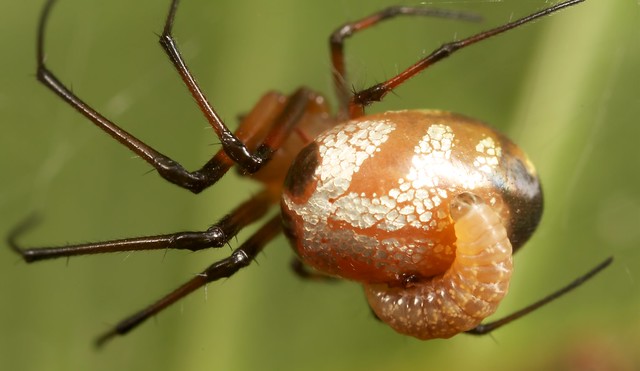
Orbweaver parasitized with wasp larva. Photographed in Iwokrama reserve, Guyana. Copyright Paul Bertner 2010.

Parasitized comb-footed spider (Theridiidae) with young. Photographed in Bukit Barisan national park, Indonesia. Copyright Paul Bertner 2013.

In an interesting twist, the young spiderlings can be seen feeding on the pupa parasitizing the adult comb-footed spider (Theridiidae) with young. Photographed in Bukit Barisan national park, Indonesia. Copyright Paul Bertner 2013.
The natural history of parasites and their hosts is typically grim. However, in the case of the pompilidae it is positively gruesome. First the prey is stung and paralyzed.
Next the legs are chewed off to immobilize the spider, so that it cannot dig its way out once the paralytic venom has warn off and it has been sealed in an underground chamber.
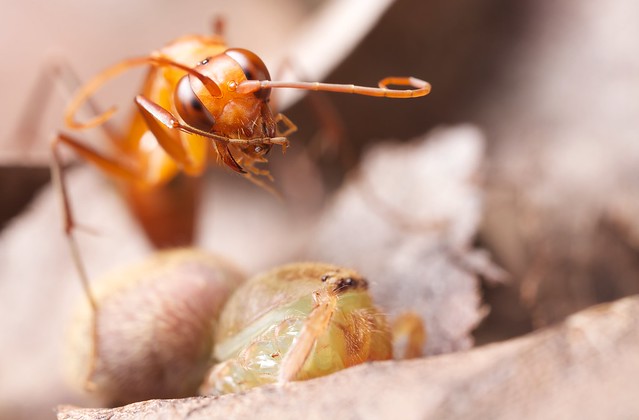
Pompilid wasp with spider prey with legs removed. Photographed in Ankarana national park, Madagascar. Copyright Paul Bertner 2011.
Finally it is dragged into a burrow, sometimes the spider’s own, or else one that has been excavated especially for this purpose, and then eggs are deposited in the body. Here they grow and mature, initially feeding off of the spider’s hemolymph. But as they begin to grow, so too does their appetite. The begin to consume the internal organs, beginning with those that won’t immediately kill their host, prolonging its life and the parasite’s environment. Only after days and weeks, when the larva has sufficiently grown does it consume the vital organs, killing the host. Next it forms a pupa where it will undergo transformation to its final adult form. After pupation it excavates its way out of the spider’s mausoleum and begins the cycle anew.
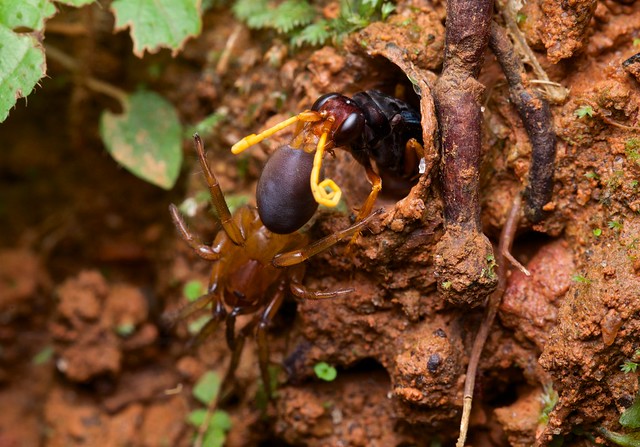
Pompilid wasp with orbweaver prey. Photographed in Amani nature reserve, Tanzania. Copyright Paul Bertner 2014.
I have found a good background in biology to be invaluable in both finding and understanding natural phenomena. Originally in the below photo only a small patch of agglutinated sand and moss was visible. Having seen wasps and other insects depositing such materials in preparation for oviposition I gently scratched away the surface to reveal two sparassids. Within seconds a nearby line of ants stumbled across the still-living spiders and started to cart them off. Without some kind of an integrated understanding of the life history of some parasitic wasps I never would have made such a discovery.
3) Cordyceps
Cordyceps is an interesting entomopathogenic fungus (a fancy way of saying a fungus that parasitizes and kills insects/spiders). Each Cordyceps is species specific and is something pretty horrifying. The spores will land on an insect and gradually the fungal mycelia will grow down past the insects exoskeleton and into the body where they will spread like tree roots, invading and replacing host tissue. This kills the insect in a very slow, lengthy process. In the final stages, the fungus takes the neurological reins and modifies the insect’s behaviour so as best to benefit itself. In ants it will cause them to climb to a high perch and bite down on a leaf or stem with a death grip. The ant will slowly die, perhaps from starvation, perhaps from the deterioration of its body, but after some time there might be seen movement. To be sure it is extremely slow and small but it is there. If sped up, it would look like a worm wriggling out of the body. And this isn’t far from the truth. It is the fruiting body of the cordyceps fungus. Which grows a stalk several inches long, terminating in asci or sacs containing the spores that will lead to a new round of infectious dissemination. Why go to all this trouble to cause the ant to climb to a high perch? Well, the jungle is very humid with rain falling often and in large quantities. Ants being principally ground dwellers, it wouldn’t do to have the ants and fungus along with them washed away, covered in mud or stuck together. Additionally, just like climbing to the top of a mountain will afford a better view of the surroundings, so too will climbing to the top of a plant or bush in a jungle microenvironment. From here, the fungus is free to be blown in all directions by the slightest current of wind, the spores, like insidious grains of pollen, waiting to be planted in the fertile backs of their hosts. Some areas are so stricken by this plague that entire ant colonies are decimated and surrounding plants become ghostly graveyards. A timelapse video of a growing Cordyceps documented in the BBC Life series by David Attenborough can be seen below.
Cordyceps comes in a variety of shapes and even colours. Though most are pale grey, white and brown, some can be an astonishing pink or even red. I have found that my preference is for black backgrounds rather than those incorporating natural light as there is less of a distraction, especially since the fungus itself is quite thin and unless the bokeh is absolutely smooth then shapes and patterns can prove distracting. A diagonal presentation will enable the greatest magnification and frame-filling which is important for such the long fruiting body which can be many times the body length of the actual subject. Though not a problem with single filament fungi, some fruiting bodies are multi-branched, like dendrites and therefore are more amenable to focus stacking. Again before and after shots of living and dead specimens can make for interesting comparative study, as well as a timelapse like the above video (though this might require weeks and it is important to find a specimen infected early on which can be difficult).

Spider infected with cordyceps fungus. Photographed in Mache-chindul reserve, Ecuador. Copyright Paul Bertner 2011.

Jumping spider infected with cordyceps fungus. Photographed in Danum Valley Conservation Area, Borneo. Copyright Paul Bertner 2014.

Spider infected with cordyceps fungus. Photographed in Cuc Phuong national park, Vietnam. Copyright Paul Bertner 2013.
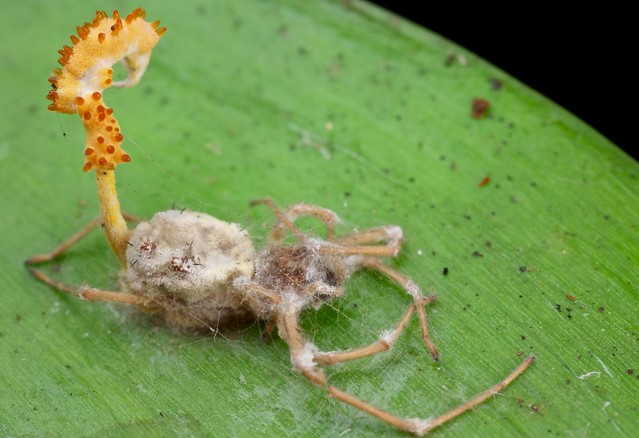
Spider infected with sporulating cordyceps fungus. Photographed in Cuc Phuong national park, Vietnam. Copyright Paul Bertner 2013.

Lynx spider posing beside a cordyceps an already infected lynx spider . Photographed in Angkor Wat, Cambodia. Copyright Paul Bertner 2013.
In a fascinating twist, one species has used the ubiquity of dead, fungus-killed spiders as means of camouflage.
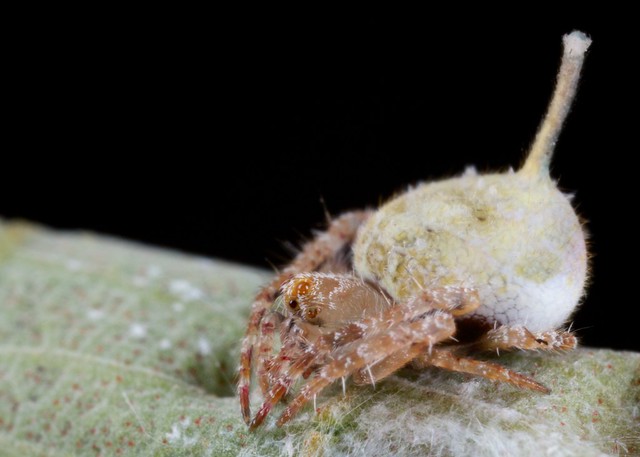
A wonderful, totally alive, orbweaver which mimics a dead, cordyceps infected corpse. Photographed in Cuc Phuong national park, Vietnam. Copyright Paul Bertner 2013.
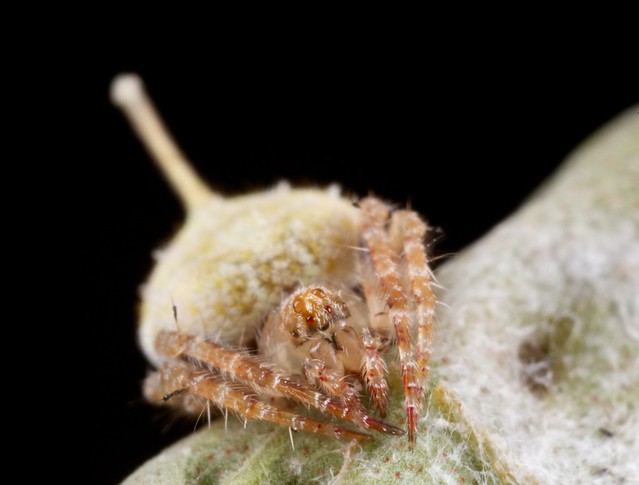
A wonderful, totally alive, orbweaver which mimics a dead, cordyceps infected corpse. Photographed in Cuc Phuong national park, Vietnam. Copyright Paul Bertner 2013.
Behaviours
Ant mimicry
(Myrmarachne spp.)

Calomyrmex ant with horsefly. Photo taken in Danum Valley, Malaysian Borneo. Copyright Paul Bertner 2014.

Female red Calomyrmex ant-mimicking jumping spider (Myrmarachne sp.). Notice the gaster held upright in a manner similar to the model, a clear display of behavioural mimicry. Photo taken in Danum Valley, Malaysian Borneo. Copyright Paul Bertner 2014.

Male Calomyrmex ant-mimicking spider (Myrmarachne sp.). Photo from Danum Valley, Borneo. Copyright Paul Bertner 2014.

Female Calomyrmex ant-mimicking jumping spider. Photo taken in Selangor, Malaysia. Copyright Paul Bertner 2013.

Male ant-mimicking jumping spider (Myrmarachne sp.) with model ant. Photo taken in Mt. Isarog national park, Philippines. Copyright Paul Bertner 2014.

Diacamma ant-mimicking jumping spider (Myrmarachne sp.). Photo taken in Danum Valley, Malaysian Borneo. Copyright Paul Bertner 2013.

Model and mimic were found in the same vicinity within feet of each other. However, the two were put together here for illustrative purposes as the sharp-eyed myrmarachne typically wouldn’t be found quite this close to the aggressive diacamma ant. Photo taken in Danum Valley, Malaysian Borneo. Copyright Paul Bertner 2013.
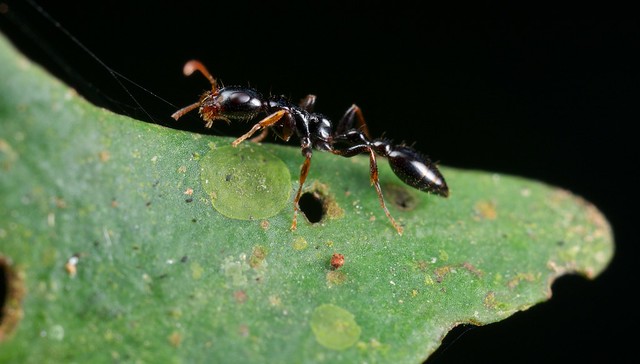
Model ant possibly Pseudomyrmex sp. Photo taken in Cuc Phuong national park, Vietnam. Copyright Paul Bertner 2014.

Female ant-mimicking jumping spider (Myrmarachne sp.). Photo taken in Cuc Phuong national park, Vietnam. Copyright Paul Bertner 2014.

Backlit weaver ant, a model sp. for numerous types of ant mimic. Photo taken in Cat Tien national park, Vietnam. Copyright Paul Bertner 2013.

Male weaver ant-mimicking spider (Myrmarachne plataleoides). Photo from Angkor Wat, Cambodia. Copyright Paul Bertner 2013.

Female ant-mimicking jumping spider (Myrmarachne plataleoides). Photo taken in Angkor Wat, Cambodia. Copyright Paul Bertner 2013.

Female Polyrhachis ant-mimicking jumping spider. Photo taken in Angkor Wat, Cambodia. Copyright Paul Bertner 2013.
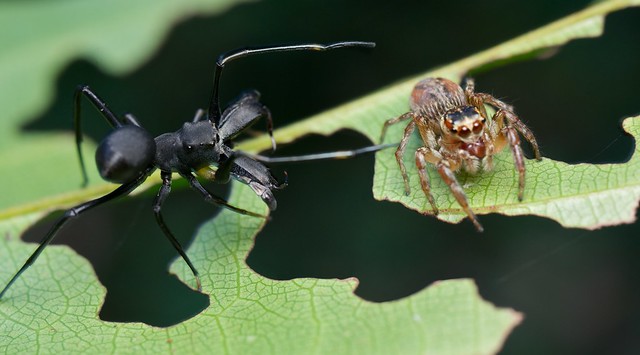
Male Polyrhachis ant-mimicking jumping spider defending its territory from another salticid. Photo taken in Angkor Wat, Cambodia. Copyright Paul Bertner 2013.

Male and female ant-mimicking jumping spiders (Myrmarachne sp.). Note the sexual dimorphism between the male and female to the extent that they have different models which they mimic. Photo taken in Angkor Wat, Cambodia. Copyright Paul Bertner 2013.
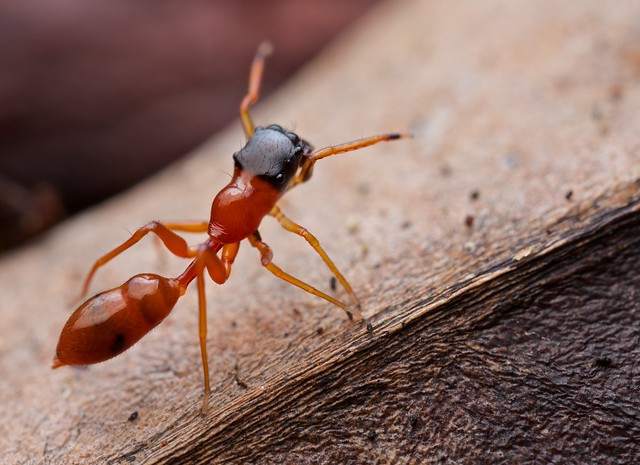
Teteraponera ant-mimicking jumping spider (Myrmarachne sp.). Photo from Vohimana reserve, Madagascar. Copyright Paul Bertner 2015.
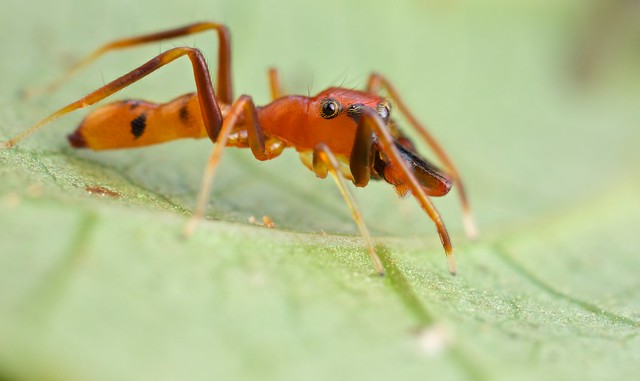
Teteraponera ant-mimicking jumping spider (Myrmarachne sp.). Photo from Vohimana reserve, Madagascar. Copyright Paul Bertner 2015.
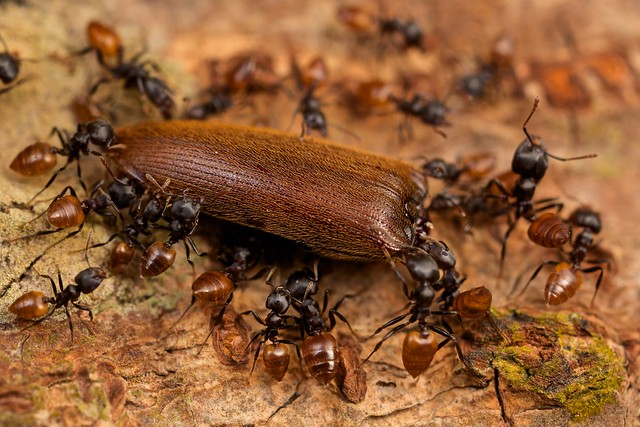
Carpenter ants with click beetle prey. Photo from Virunga national park, Democratic Republic of Congo. Copyright Paul Bertner 2015.

Ant-mimicking jumping spider (Myrmarachne sp.) from Virunga national park, DRC. Copyright Paul Bertner 2015.
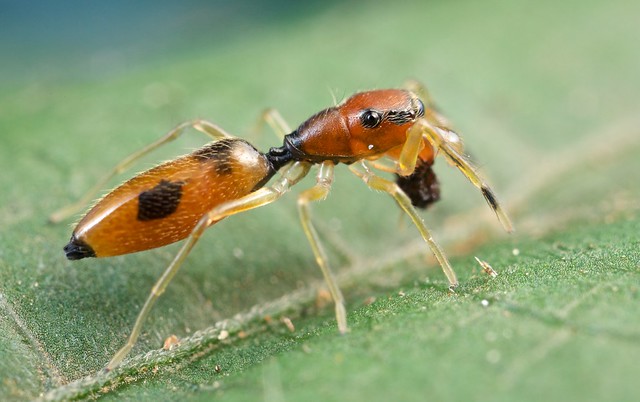
Ant-mimicking jumping spider (Myrmarachne sp.) from Virunga national park, DRC. Copyright Paul Bertner 2015.
Sac spiders (Clubionidae, Corinnidae)

Ant-mimicking corinnid spider. Photo taken in the Kanuku mountains, Guyana. Copyright Paul Bertner 2010.

Ant-mimicking corinnid spider. Photo taken in the Kanuku mountains, Guyana. Copyright Paul Bertner 2010.
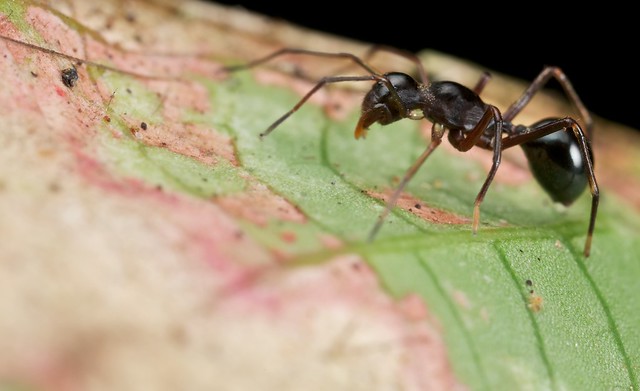
Ant-mimicking corinnid spider. Photo from Danum Valley, Malaysian Borneo. Copyright Paul Bertner 2014.

Polyrhachis armata a similar model ant species. Photo taken in Danum Valley, Borneo. Copyright Paul Bertner 2014.

Polyrhachis armata-ant mimicking corinnid spider. Photo taken in Angkor Wat, Cambodia. Copyright Paul Bertner 2013.
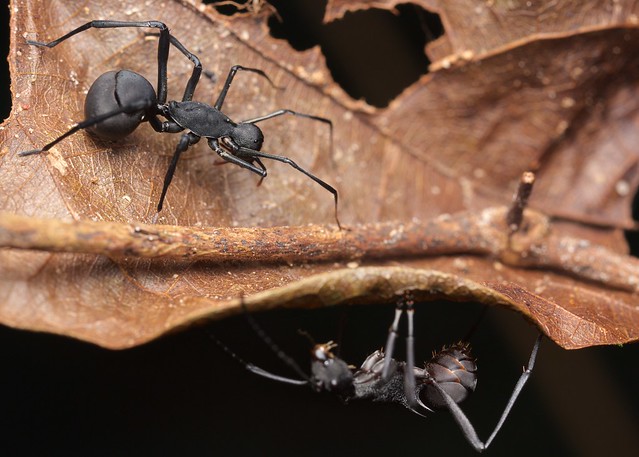
Ant-mimicking corinnid spider with ant model (Polyrhachis armata). Photo taken in Angkor Wat, Cambodia. Copyright Paul Bertner 2013.
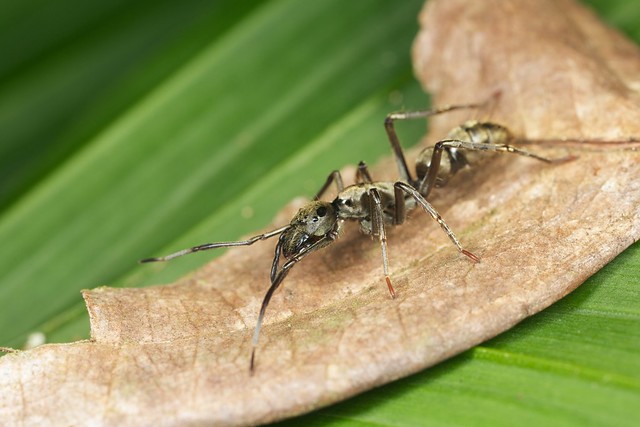
Ant-mimicking corinnid spider (Sphecotypus niger) mimics ant model Pachychondyla villosa. Photo taken in Corcovado national park, Costa Rica. Copyright Paul Bertner 2013.

Ant-mimicking corinnid spider (Sphecotypus niger) mimics ant model Pachychondyla villosa. Photo taken in Corcovado national park, Costa Rica. Copyright Paul Bertner 2013.
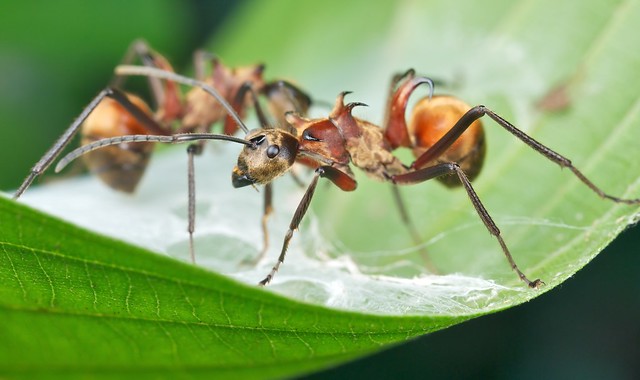
Polyrhachis bihamatum model ant. Photo taken in Danum Valley, Malaysian Borneo. Copyright Paul Bertner 2014.

Golden fishhook ant (Polyrhachis bihamata)-mimicking corinnid spider. Photo taken in Gunung Leuser national park, Sumatra, Indonesia. Copyright Paul Bertner 2013.
Pranburia spp.

Ant-mimicking corinnid spider (Pranburia manhoppi). Photo taken in Angkor Wat, Cambodia. Copyright Paul Bertner 2013.

Yellow crazy ant (Anoplolepis gracilipes) with midge prey. Photo taken in Angkor Wat, Cambodia. Copyright Paul Bertner 2013.

Crazy ant mimicking corinnid spider (Pranburia sp.). Photo taken in Angkor Wat, Cambodia. Copyright Paul Bertner 2013.

Crazy ant model and ant-mimicking spider (Pranburia sp.). Photo taken in Angkor wat, Camodia. Copyright Paul Bertner 2013.
Wasp mimicry
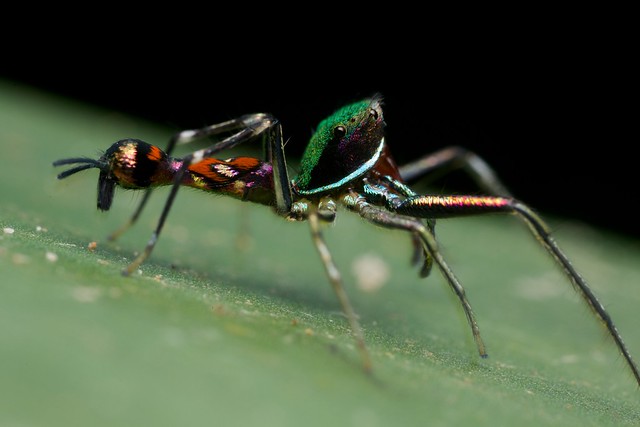
Orsima ichneumon is thought to mimic ichneumon wasps or velvet ants. Photographed in Selangor, Malaysia. Copyright Paul Bertner 2013.
Ladybird mimicry
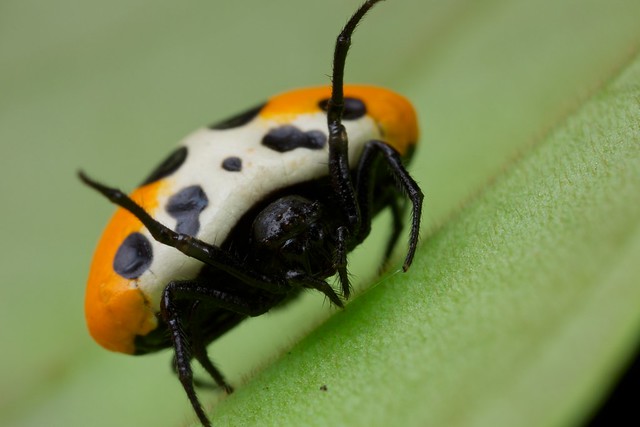
Paraplectana sp. mimics the aposematic, alkaloid-filled ladybirds. Photographed in Cuc Phuong national park, Vietnam. Copyright Paul Bertner 2013.
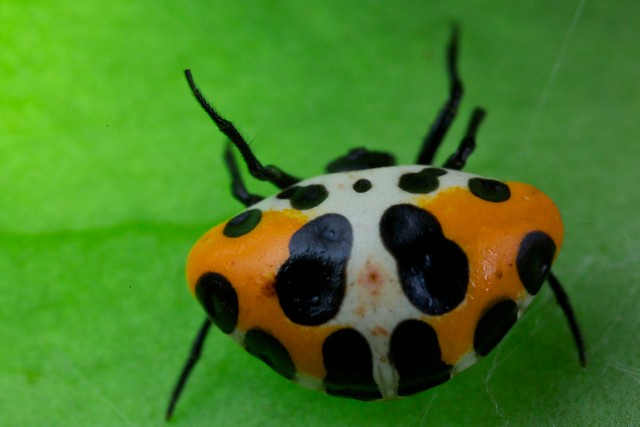
Paraplectana sp. mimics the aposematic, alkaloid-filled ladybirds. Photographed in Cuc Phuong national park, Vietnam. Copyright Paul Bertner 2013.
Beetle mimicry
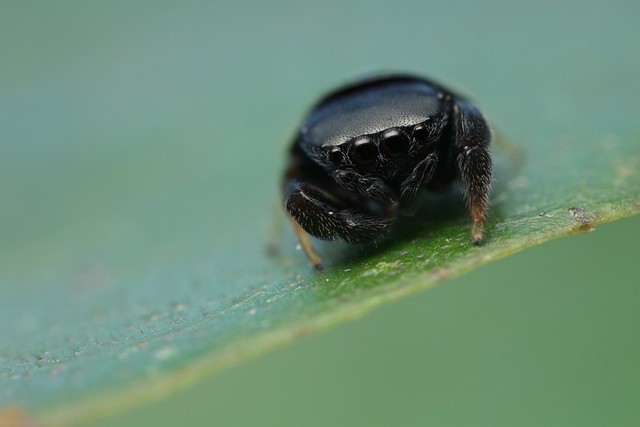
Beetle-mimicking jumping spider (Pachyballus cordiforme). Photographed in Udzungwa national park, Tanzania. Copyright Paul Bertner 2014.
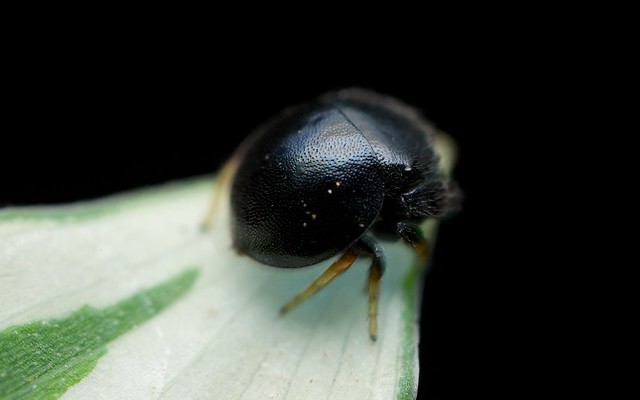
Beetle-mimicking jumping spider (Pachyballus cordiforme). Photographed in Udzungwa national park, Tanzania. Copyright Paul Bertner 2014.
Group 2 – Tailless whip spiders (Amblypygi)
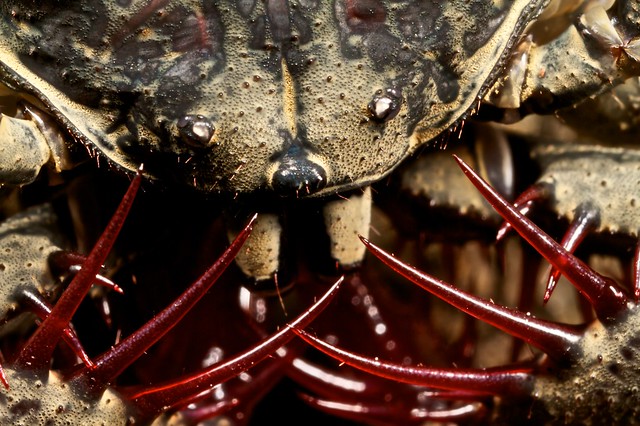
Tailless whip spider (Heterophrynus alces) from Iwokrama reserve, Guyana. Copyright Paul Bertner 2010.
If it weren’t for the fact that these arachnids are utterly harmless and slightly more obscure than the mygalomorphs and scorpions, they would certainly occupy a distinguished position in the vanguard of nightmares’ creatures. However, to label them as a simple curiosity or a Halloween special does them a disservice. They form an ancient, and successful sister-clade (branch with most recent common ancestor) to the vinegaroons (Uropygi) and schizomida (microwhip scorpions). Their adaptations (dorso-ventral flattening of the body, spinose raptorial pedipalps and modification of forelegs into exquisitely sensitive sense organs) have led to successful speciation (155 species in 5 different families) and radiation across the tropics.
Like most creatures occupying the realm of nightmares, she emerges when sun yields to night, and our imaginations conquer good sense. She may materialize from a cavern or cave, a burrow or some long-abandoned retreat. She advances tentatively into the open, her sedate pace belying her incredible agility and speed. Her obscenely long forelegs swing to and fro, scanning, probing the ground ahead of her for potential prey, mates or rivals. These highly modified legs appear as long, fragile extensions (or ‘whips’) but they are instrumental in forming an image of her environment since the small clusters of ocelli on her prosoma (cephalothorax) are oriented upwards and serve little purpose in the highly detailed and colour-based sight as we know it (rather they are thought to function in the regulation of circadian rhythms by discerning light/dark cycles, as well as the perception of vague movements, and overhead obstacles (important in determining the exposure of her daytime retreat). The antenniform legs also play a key role in hunting; packed with a dense diversity of afferent (sensory) receptors in the form of (at least) 7 different types of sensillae.

Tailless whip spider antenniform leg closeup showing sensory hairs. Photographed in Bilsa reserve, Ecuador. Copyright Paul Bertner 2011.
These receptors range from the mechanosensory slit sensillae (important in the perception of mechanical deformation and/or strain), trichobothria (measuring pressure differentials), joint receptor(s) (proprioceptor(s) which sense stimuli arising within the joint regarding position, motion, and equilibrium) to chemosensory (mostly olfactory) sensillae. While the bulk of the sensory information appears to come from the antenniform legs, and indeed these play a crucial role as outlined above, other mechano/chemosensory organs have been found on the claws and pedipalps, perhaps ensuring a level of redundancy in case the fragile forelegs are damaged, severed or lost by autotomy (a survival strategy whereby a limb is sacrificially amputated (a pre-severed limb is held together along fracture planes (1), and it is the controlled failure of adhesion mechanisms through internal and external forces which allow the limb’s release) to assure the safety of the organism as a whole). The combination of these sense organs help Amblypygi develop and maintain a multi-dimensional awareness of their environment, while mushroom bodies and neuropils (areas of dense synaptic connectivity) found within the brain have been associated with more complex behaviours such as learning and memory and the more recently hypothesized integration of diverse and complex stimuli (2), (3). Essential to the relay of all this information are giant peripheral interneurons occupying the antenniform legs, and though the full extent of their role has yet to be determined, it has been posited that the increased diameter of the axonal fibres and hence faster conduction speeds are important in the large distances that a signal must travel within these elongated limbs, which would otherwise suffer from signal degradation and lengthier stimulus-response times.
While in situ studies of predatory behaviour are few and far between, there are several laboratory studies which demonstrate a 4 stage hunting strategy: 1) Prey is first encountered and assessed. The antenniform legs are alerted to the presence of prey by airborne or ground vibrations enabling the reorientation, aiming and tracking of the prey while the body as a whole remains stationary. Mechanosensory sensillae determine the prey’s distance and relative position, while olfactory organs determine the prey type. Unfortunately there is insufficient data to determine whether Amblypygi adapt their hunting strategies to specific prey size and type; however, given the sheer number and diverse types of sensillae it stands to reason that there is probably a certain degree of prey discrimination 2) Next, the antenniform legs will gently contact either side of the prey (surprisingly without initiating the prey’s flight response). This is thought to either guide the prey into a more vulnerable position, or else to provide additional information 3) The whip spider then unfolds its pedipalps revealing raptorial spines and frames the prey with its antenniform legs without actually touching it, composing a strike ‘image’ to accurately judge distance, speed, etc. 4) Finally the sensory legs are swept aside as the prey is impaled on the spines of the open pedipalps.

Tailless whip spider (Heterophrynus alces.) from Iwokrama reserve, Guyana. Copyright Paul Bertner 2010.

Tail-less whip spider (Heterophrynus sp.) with cricket prey. Photographed in Jatun Sacha reserve, Ecuador. Copyright Paul Bertner 2011.
Observations of mating amblypygi are rare in the wild, and photos even more so; however several documented accounts relate a scenario similar to the more familiar scorpion and Uropygi mating rituals. Notably, a short courtship involving a touching and stroking of the forelegs, a pedipalp embrace, the deposition of a spermatophore directly onto the substrate and the guidance of the female by the male over the sperm packet upon which she lowers herself. Eggs develop in a case held below the opisthosoma (abdomen) and hatch approximately 3-4 months later.
Like some other basal lineages (Thelyphonida and Scorpions), mothers exhibit a degree of subsocial behaviour (ie. care for their young). This is most obvious in the manner in which they carry their newly hatched young (first instar stage) on their backs until their first moult (second instar stage) when their antenniform legs become sufficiently developed to allow them to hunt for themselves. This seemingly trivial extension of maternal care offers substantial evolutionary advantage in neonatal survivorship at a time when mortality rates are at their highest. Furthermore some species have been demonstrated to show kin recognition in successive moults with concomitant decreases in aggression (4).
Photographs of this group typically rely on frontal portraits of the head and pedipalps. This highlights two key features: 1) The eyes; though functionally of little value these are still important compositionally, and 2) The spines which ornament most/all amblypygi pedipalps. This is an effective view and probably offers the most advantageous perspective which includes the most features.

Tailless whip spider (Damon sp.). Photographed in Amani nature reserve, Tanzania. Copyright Paul Bertner 2014.

Tailless whip spider (Damon sp.). Photographed in Amani nature reserve, Tanzania. Copyright Paul Bertner 2014.

Tailless whip spider (Charon sp.). Photographed in Mt. Isarog national park, Philippines. Copyright Paul Bertner 2013.
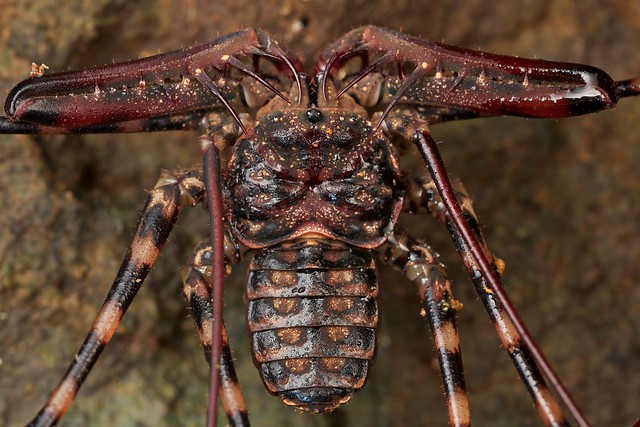
Tailless whip spider (Charon sp.). Photographed in Mt. Isarog national park, Philippines. Copyright Paul Bertner 2013.

Tailless whip spider (Damon sp.). Photographed in Amani nature reserve, Tanzania. Copyright Paul Bertner 2014.
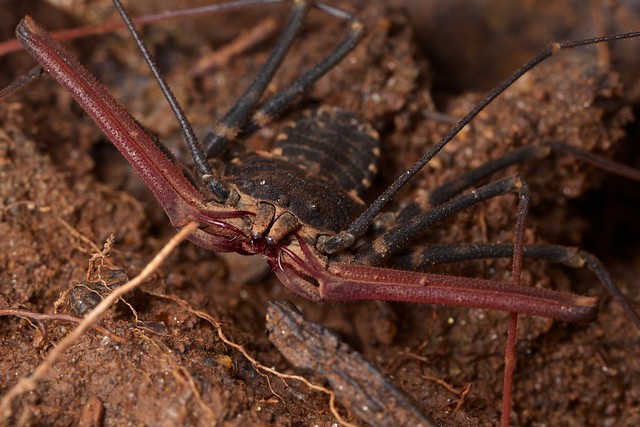
Tailless whip spider (Euphrynichus bacillifer). Photographed in Amani nature reserve, Tanzania. Copyright Paul Bertner 2014.
Other views to consider might be overhead closeups of the head (first image of this section and below).
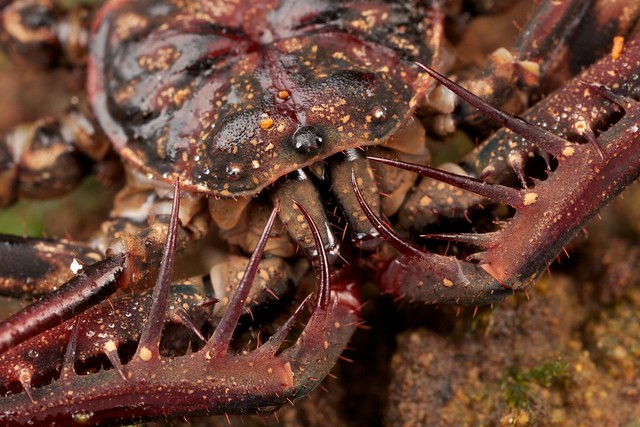
Tailless whip spider (Charon sp.). Photographed in Mt. Isarog national park, Philippines. Copyright Paul Bertner 2013.
Or else high magnification views detailing armature and spines (below). Owing to their nocturnal nature, properly photographing amblypygi within their environment through wide-angle macro can be difficult, though provided there are interesting topographical features this may be a desirable perspective. Nb. that this will require either a multi-flash setup or a single flash fired multiple times with a longer shutter speed.
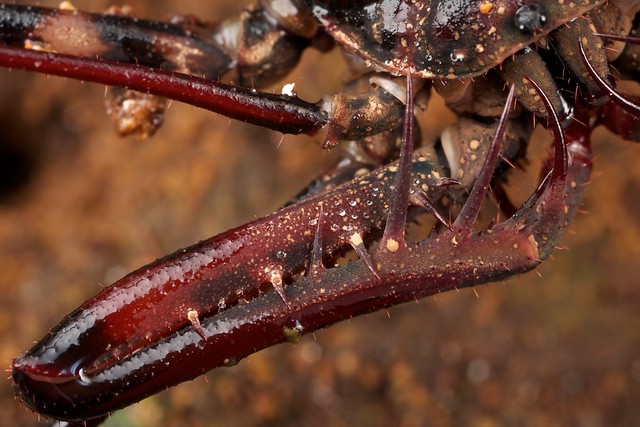
Tailless whip spider (Charon sp.). Photographed in Mt. Isarog national park, Philippines. Copyright Paul Bertner 2013.
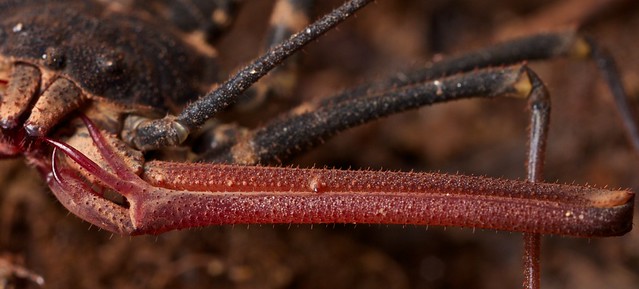
Tailless whip spider (Euphrynichus bacillifer). Photographed in Amani nature reserve, Tanzania. Copyright Paul Bertner 2014.
Alternatively, many amblypygi show beautiful translucence with delicate whites, purples and blues immediately following ecdysis (moulting). Unfortunately this highly photogenic phase is quite short-lived, usually no more than 30 minutes. Therefore if ecdysis is imminent it is probably best to remain nearby and check in frequently. During this teneral stage they also display a small amount of UV reflectance which disappears completely as the exoskeleton hardens and becomes increasingly pigmented.

Tailless whip spider (Euphrynichus amanica) under UV llight. Photographed in Amani nature reserve, Tanzania. Copyright Paul Bertner 2014.
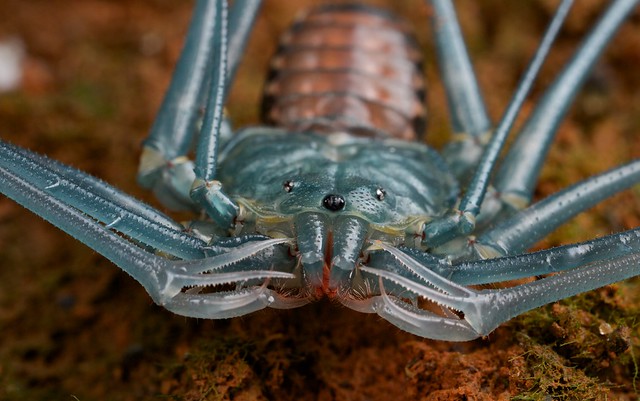
Tailless whip spider (Euphrynichus amanica). Photographed in Amani nature reserve, Tanzania. Copyright Paul Bertner 2014.
A clip from “Life in the Undergrowth” narrated by David Attenborough:
Harvestman
Acari
———————————————————————————————————-
(1) Diffusion is always a balance between proper contrast and avoiding specular highlights and over-the-top contrast. I find most diffusors tend towards one or the other. My preference is for what I call a ‘leaky diffuser’. This is a diffuser which transmits most of the light through the diffuser, however a small amount leaks around the diffusion material creating additional contrast. This diffuser is good for the majority of subjects from the hairy (which need very little diffusion) to the rough surfaced iridescent subjects (moderate diffusion required). It is only the smooth bodied and smooth bodied iridescent subjects which require a different, more aggressive diffusion approach.

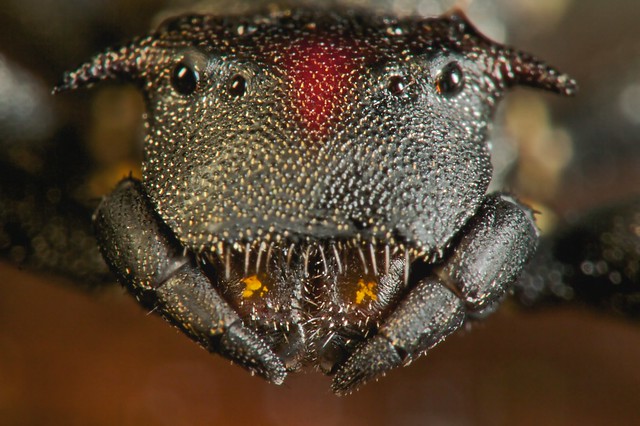

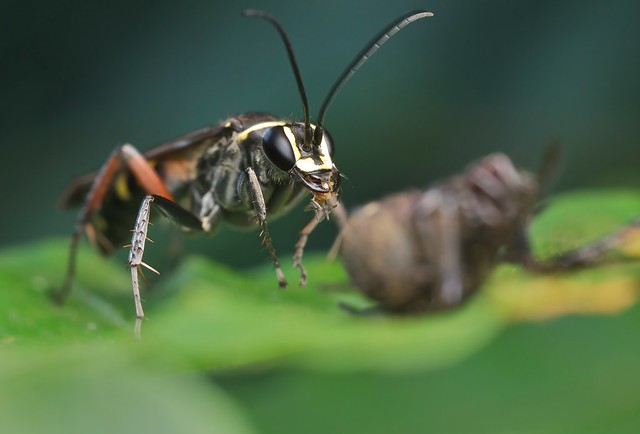
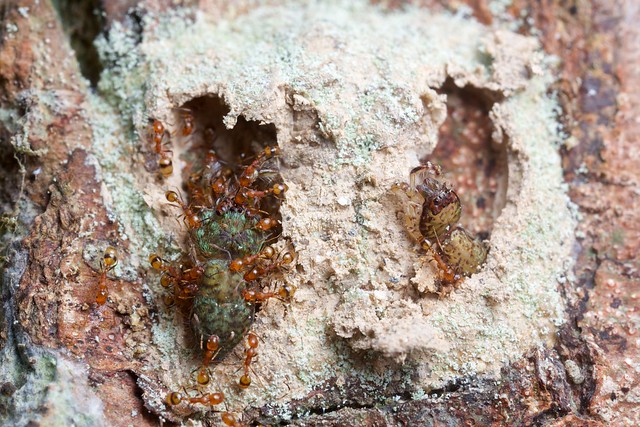
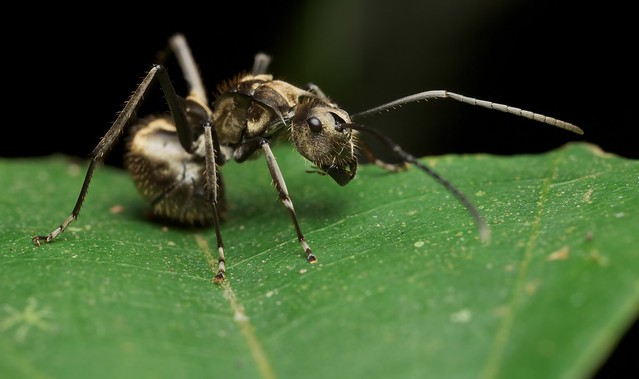
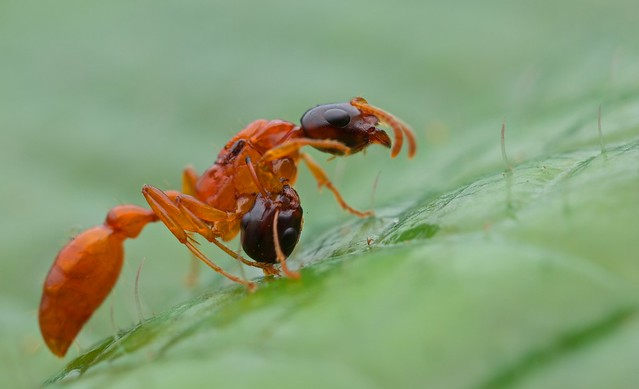

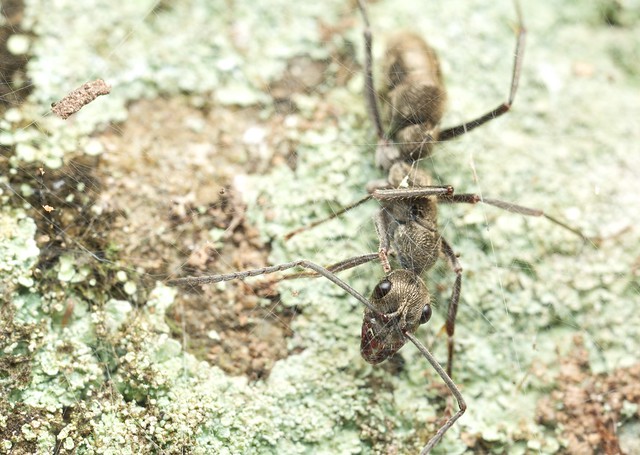
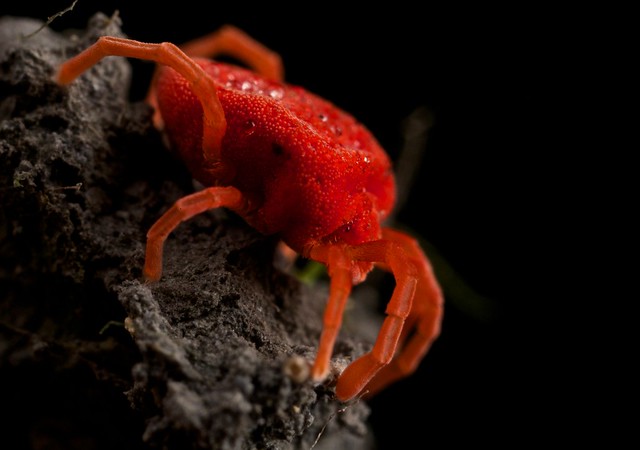



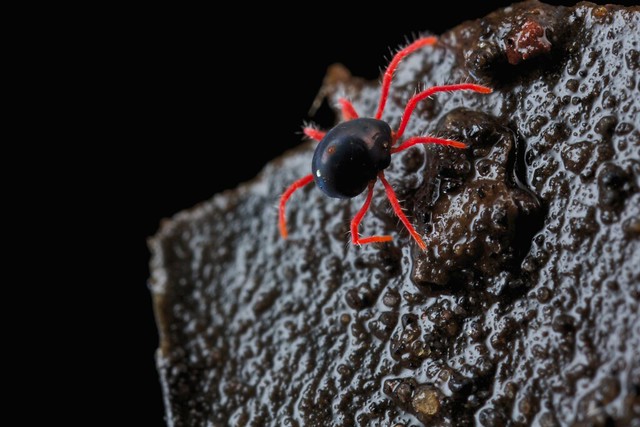
Dear Paul Bertner


I’m Arnaud Henrard, PhD student and arachnologist at the Royal Museum for Central Africa (tervuren, Belgium).
I’m currently preparing with Rudy Jocqué an article on the Phylogeny of the ant-eating spiders (Zodariidae) on a global scale, and I am searching photos to illustrate some part of the article.
I saw your very nice photos of some Zodariidae eating ant and I wonder if I can use the male and the female (which I think that could belong to the species Hermippus arcus known from Uzungwa and Usambara Mts. in Tanzania) for my article and presentations?
I will of course mention the credits.
Let me know if you agree, here is my email: arnaud.henrard@gmail.com
Truly yours
Arnaud